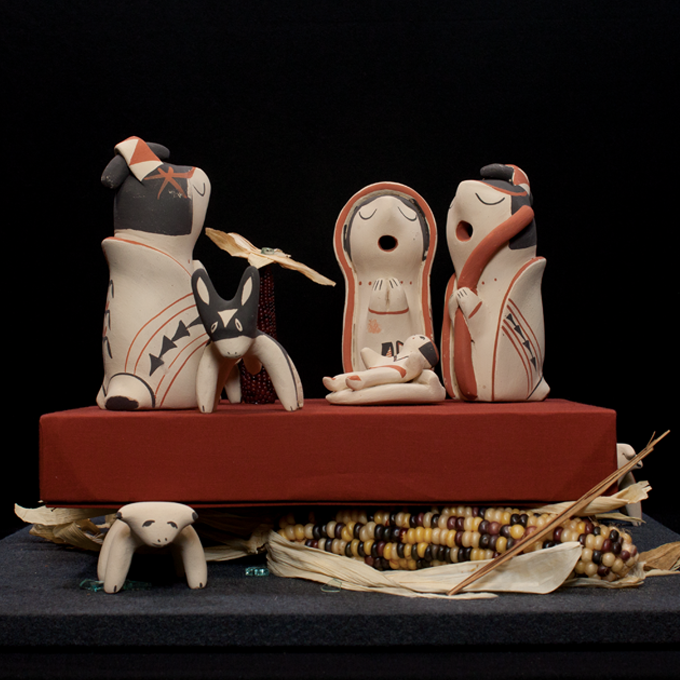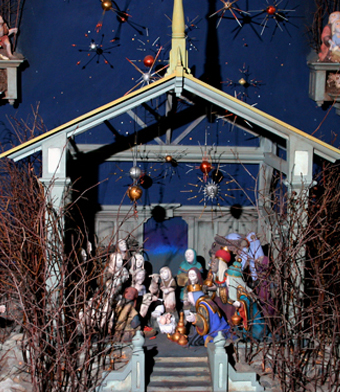United States
United States
The following Nativities are each displayed in a unique permanent setting created by Marian Library Crèche Collection volunteers. The descriptive text for each was written by Father Johann Roten, S.M.
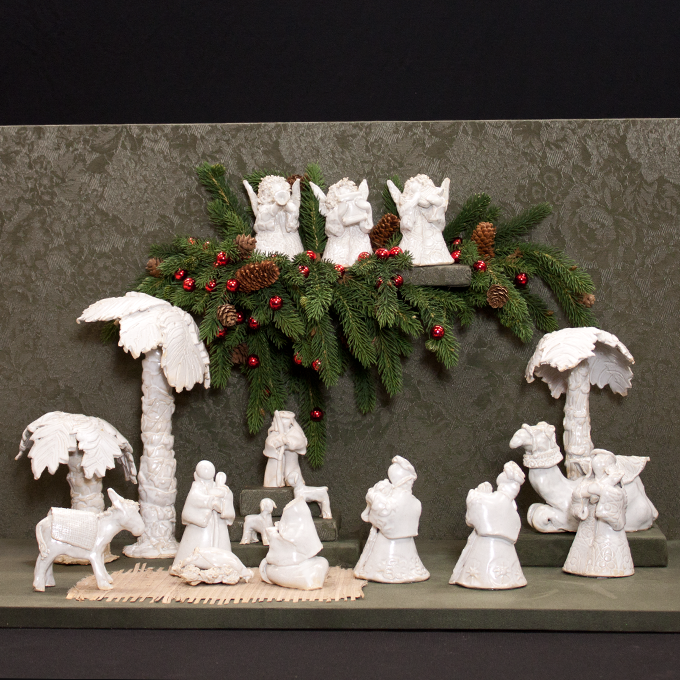
Faceless Beauty
Wava Best
Beauty is in the eye of the beholder, and not necessarily in the face of the person we see. The expressions of a face may detract from the beauty of a gesture and the elegance of a pose. Wava Best is hiding beauty in a variety of details: the gnarled trunk of a palm tree, the pudgy hands of an infant angel, the camel’s meditative snout speaking volumes of wisdom, or the wise men’s robes strewn with intertwined floral, foliate, and geometric figures. There seems to be one exception. The baby is but a formless bundle. The representation is reminiscent of early Christian iconography. Wrapped in swaddling clothes from head to toe, the Christchild’s true origin remained hidden. It remains hidden in this representation, too. It remains hidden to the eye but not to the hearts of angels, animals, parents, and wise men.
– ML.0163.01
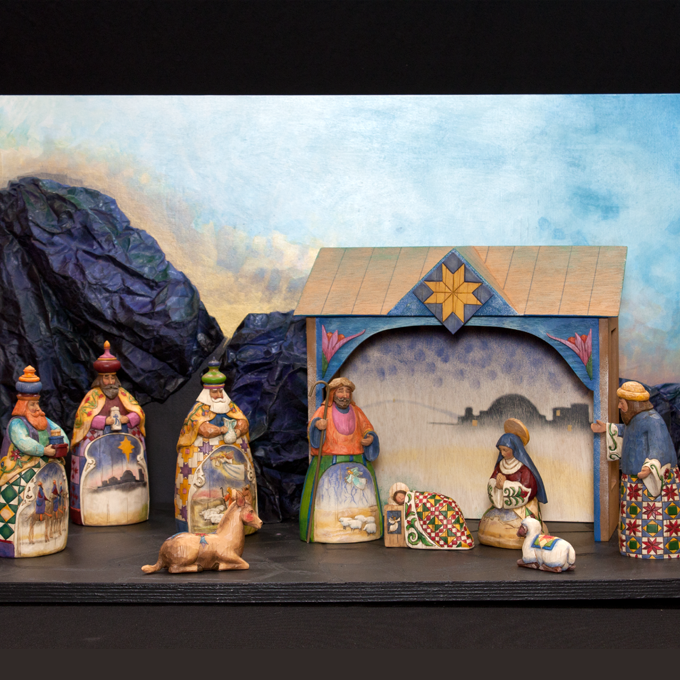
Christmas Comics
Jim Shore
The set reflects a new tendency in the U.S. Christmas culture. Jim Shore created this nativity set with painted figures for Enesco. The tradition of painted figures is part of a long history going back to pre-Columbian times. It slowly evolved from figures decorated with floral or geometric ornaments to sculptures showing tableaus of plants, animals, and entire landscapes. Subsequent development brought narratives into play when individual figures became the visual carrier of a whole story or shared in the story with other figures as suggested in our nativity set. Indeed, major episodes of the Christmas story can be “read” on each one of the figures. This tradition is well-known and was widely disseminated in Latin American countries.
– ML.1112.06
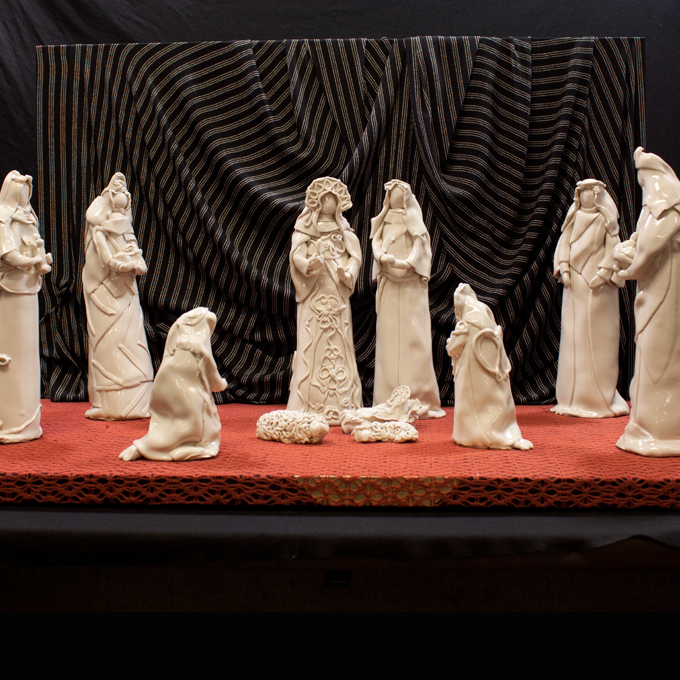
Nondescript?
Gerry Wallace
White, tall, and nondescript. Isn't this the overall impression that emerges when looking at this nativity? A fleeting glance may easily become a lasting impression. Before it happens, take another look.
The ten figures stand tall against a solemn curtain of black-and-white drapery. At their feet there is gold, both yellow and red. And, although their individual identity is not immediately evident, we intuit that each one of these personages takes part in a sacred drama. Sacred drama veils and unveils. But at all times the mystery remains intact. Here lies the meaning of this seemingly nondescript Christmas scene. There is more than faceless characters here. Isn't it as if the whole figure was shrouded in mystery? Meaning some of the mystery that only God himself can unveil for us, and which we recognize as such in faith. True mystery never wears down. It instills lightness in the soul as suggested with the dreamy arabesque decorations that ornate some of the figures.
– ML.1124.05
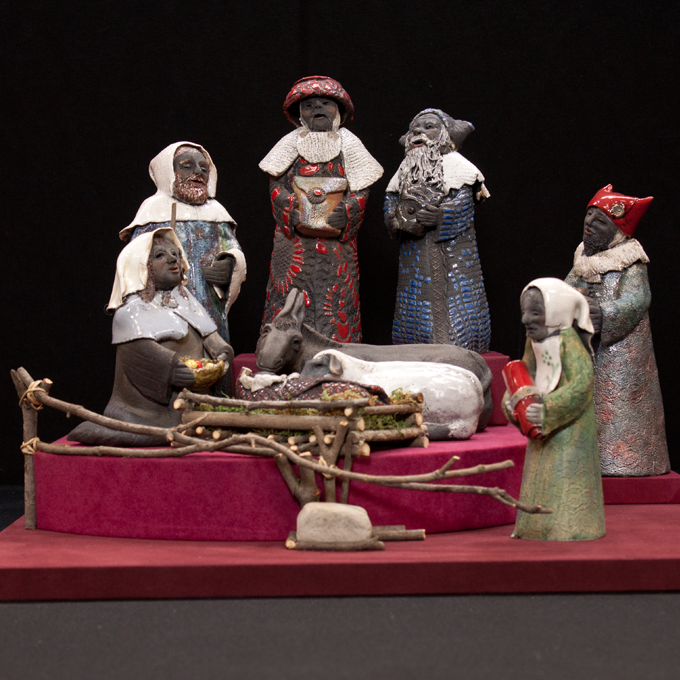
Sealed Scroll
Pelagia Bonniwell
These are Raku people, named after a Japanese earthenware going back to the fifteenth/sixteenth century and well-known for its rough and dark glaze. The artist has brightened the looks of her people by dressing them in caps and gowns of enamel-like colors. Among them is a shrunken old lady. The traits of her face speak volumes of wisdom acquired in years of wear and tear. She holds an oversized scroll, rolled and of bright red color, which she is taking to the cradle. It represents the hidden meaning of human existence, tightly wrapped and sealed. There is hope that the Christ child will unseal and decipher the puzzles of life.
– ML.0119.20
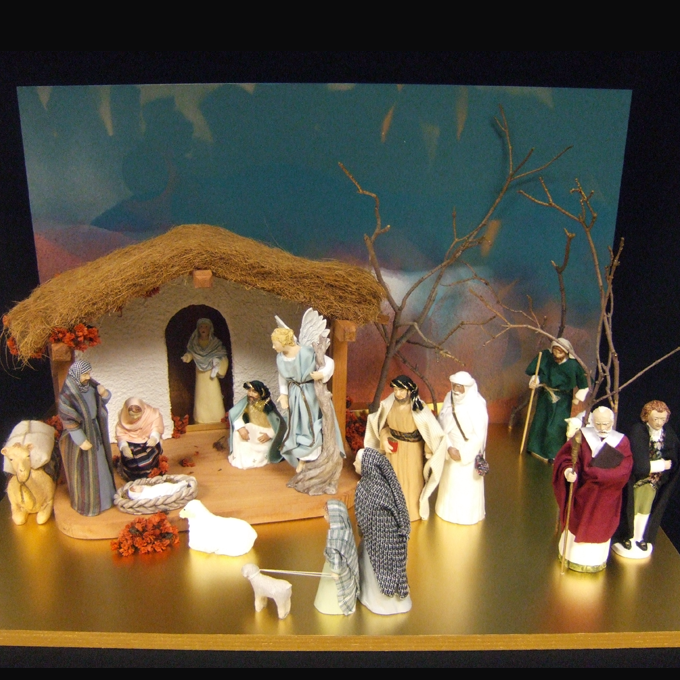
Child Prodigies
Linda d’Addario, sculptor
Jane Macdonald, dress
– Artists for Hestia Creations
Christmas lore knows no boundaries. It puts the holy family under a thatched roof but places sheep, shepherds and camel on a lustrous landing of pure gold. The artist has also added two figures which ordinarily steer clear of paupers and beasts. We notice, at some distance from the manger, the presence of Saint Nicholas of Myra and Mozart. What an odd couple, indeed!
But here they are, child prodigies, to pay tribute to one of their own. As legend goes, only three days after birth Nicholas stands upright in his bathtub, and distributes his entire fortune at a tender age to the poor. He is even better known for throwing three golden balls into the home of three impoverished maidens, allowing them to marry well. Mozart, the other child prodigy, showed exceptional musical talent at an early age, and was taken--only six years old--on a concert tour of Europe by his father. He not only composed some six hundred complete works, but was also a generous man, often depleting his own resources to help out a friend. The third child prodigy is the Christ child. We don't know about any physical prowess or artistic talents of his, but he was similarly generous: he gave his life and reputation to be one of us.
– ML.0108.10
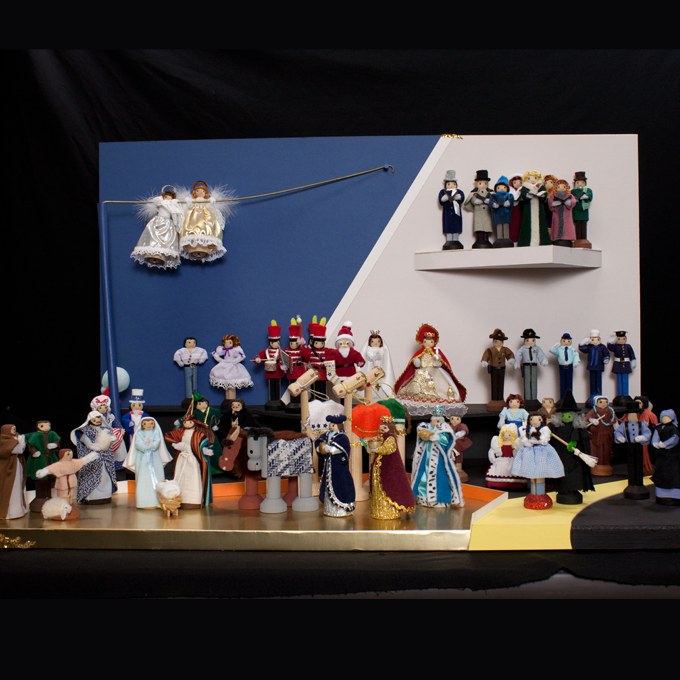
Pin People
Rita Chiavacci
In this set the habitual representatives of the nativity event are in good and richly varied company. We have a cross-section of many aspects of American life and culture. Indians greet Amish, the UPS man holds hands with the Post mistress. The Wizard dispatched some of his most faithful followers, Dorothy and the Witch. Scarlet and Rhett are not gone with the wind, but join in with Uncle Sam, the square dancers and a lonely clown. Public life is represented with a sheriff, a state trooper and navy, marine and air force personnel. Santa, toy soldiers and carolers remind us of different ways to celebrate Christmas. Even Our Lady of Fatima is part of the colorful gathering.
Pin people, made of old rounded clothespins, snippets of fabric and pipe cleaners, are simple people. They are a reminder of life's ordinariness. Pin people are dressed up clothespins, no more, no less. Behind our many faces and checkered individualities there is the simple and ordinary myself. To forget this would make us lesser selves. Remembering it is healing power.
– ML.2639
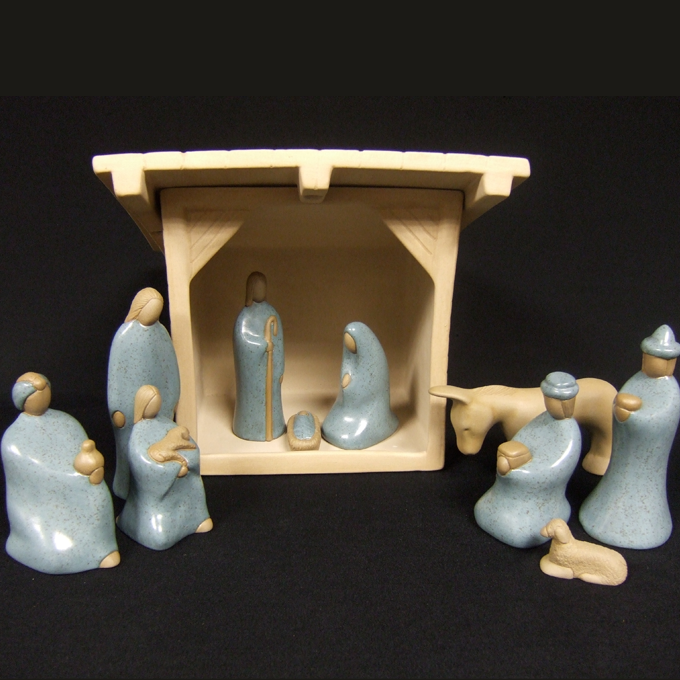
Blues
Jack Black
In 1931, Auguste Piccard became the first to reach the stratosphere in a pressurized cabin. "The sky is beautiful up here," he wrote. "It is almost black, a bluish purple a deep violet shade, ten times darker than on earth, but it still is not quite dark enough to see the stars."
The setting of Jack Black's Christmas scene pays tribute to the conquest of the skies. Engulfed in the black and blue immensity of the universe, the square and sturdy home of the Holy Family sails through space, taking in tow all other figures which make up the odyssey of Christ's coming. The flying fortress is heading for a region where the skies are dark enough to see the stars. And as we watch, we somehow know that soon it will disappear from our field of vision, and enter the starlit depth of our own soul. So there is no reason for the blues! Christ conquers without destroying; he sometimes conquers without our knowing and realizing: "If I climb the heavens, you are there," says the Psalmist. He also says: "If I lie in the grave, you are there."
– ML.0084.17
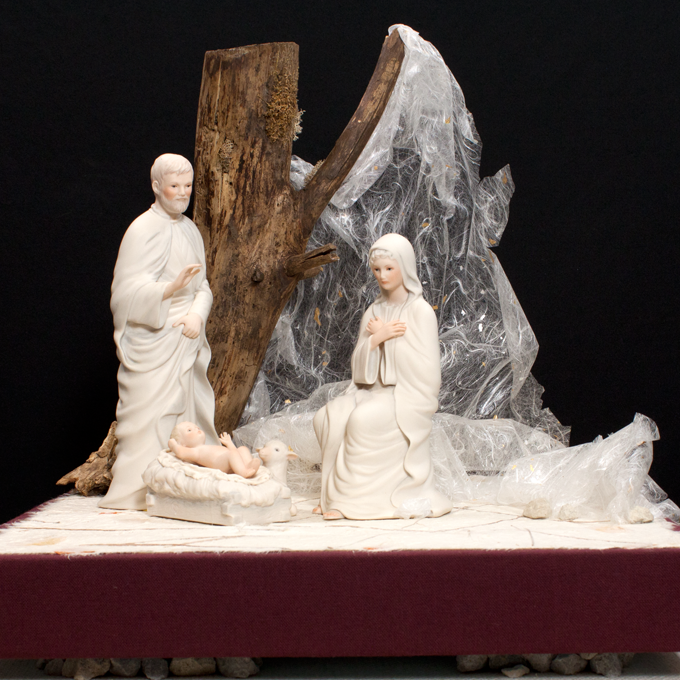
Rarified Beauty
Artist unknown
There was a time, long ago for some but not so long ago for others, when religion marked a clear difference and opposition to the things of this world. The saints, people of the other world, were accordingly pictured. Embodying the triumph over the laws of gravity and transitoriness, they were meant to look disembodied. They were, as in this set, of rarefied beauty, intentionally made to so convey the impression of diaphanous and insubstantial reality. They were heavenly – and looked it. Meanwhile, the focus of the Christian message has shifted to more this-worldliness, as other nativity scenes have shown. Today, artistic taste gives preference to a more corporeal humanness. However, the pendulum of history keeps swinging in two directions, meaning that there is – in the long run – no this-worldliness without other-worldliness. Distance and purity – as pictured in this nativity scene – have perennial value.
– ML.0040.03
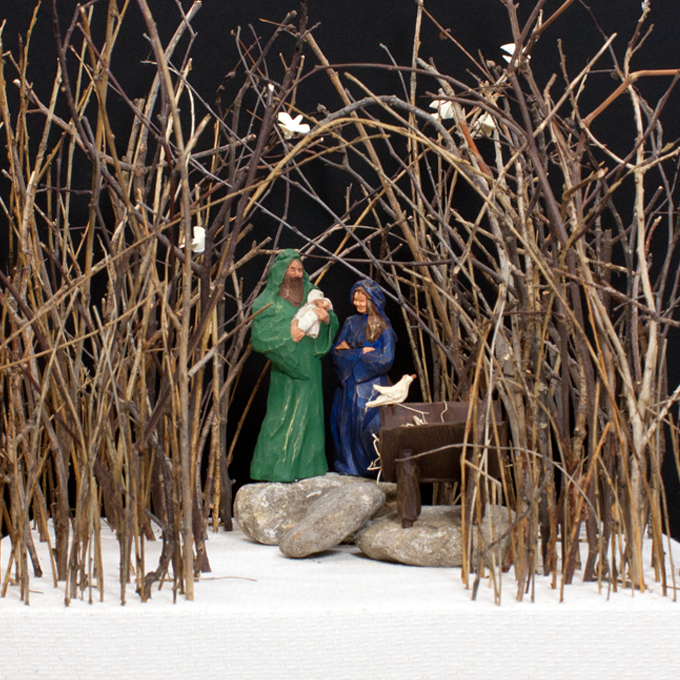
Like Wife, Like Husband
Karin Howard
In older representations of the nativity, Joseph rarely enjoys great press. Frequently he stands or sits apart from mother and child, a useful handyman at most. Some scenes show him brooding, his mind in suspense, lack of conviction written all over his face. There are also pictures where he simply sleeps the sleep of the just.
The scant attention given him by early Fathers and Doctors of the Church may have influenced his marginal position. Saint Augustine and other thinkers wrote of Saint Joseph, but his mention is sparse. The tide turned slowly. The reflection about his dignity and holiness began to flower in Medieval times. The seventeenth, and again the nineteenth centuries, were the golden age of a sometimes enthusiastic devotion to the third person of the Holy Family. He rightly deserves respect and affection. A connoisseur once simply defined him: "Like wife, like husband."
A new appreciation of Saint Joseph at the end of this century casts him in the role of the solicitous husband and father figure. In an attempt to redefine the division of labor within the Holy Family, he is now the one who holds the baby and rocks him to sleep.
– ML.0116.10
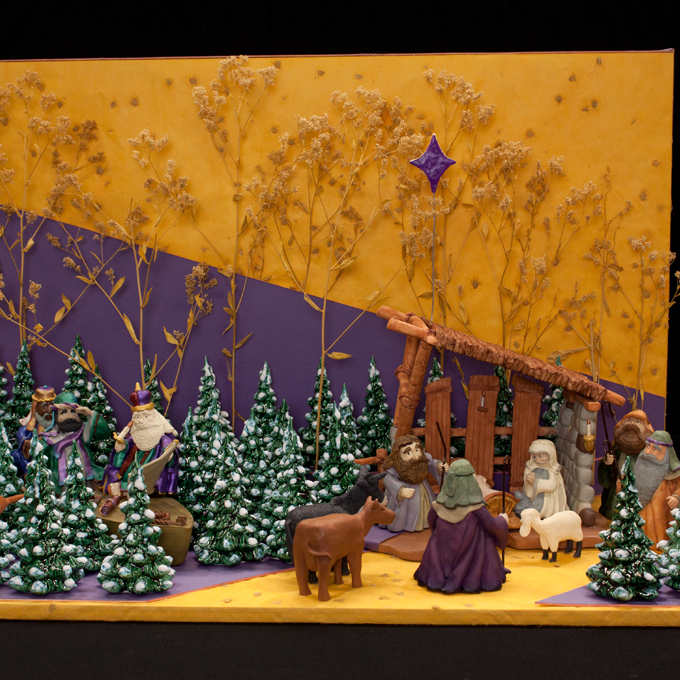
Between Light and Darkness
Dennis Brown (ENESCO)
Solid, burly but gentle, these figures inspire trust and confidence, and one would not mind being led by them to the manger. Dennis Brown adopted a crèche style which has become popular in the United States. It favors a rough-and-tumble simplicity over sophistication, puts childlike faces on people and endows them with the smile of never- ending contentment. It is a deliberately primitive version of "paradise retrieved." The setting of this nativity suggests the theme of light and darkness, the need to find a way out of the maze of human existence. Coming into the light is a challenge because the birth of the "light-Child" did not take away all darkness. In fact, the line of demarcation between light and darkness is crossing the threshold of the stable. Thus, the search for the full light is still on. In this nativity set the seekers are the wise men. They come by boat, entangled in a maze of trees, but soon they will see the light.
– ML.2619
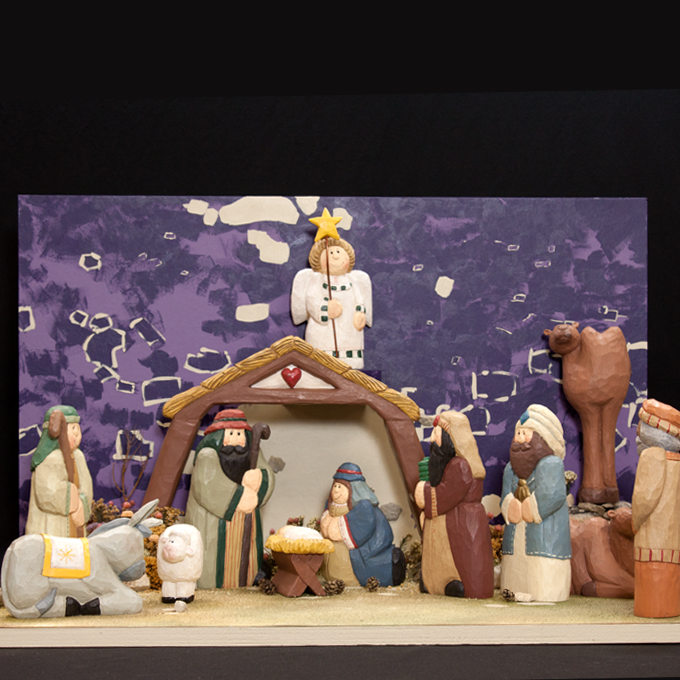
With Children's Eyes
Eddie Walker
There is the child, and there is the child in the adult. Both dwell in a children's world or crave, at times, to return to the simpler years and uncomplicated innocence of childhood. Eddie Walker has created his burly figures and smiling faces to take us back to a time when angels carried stars, a sheep was not really a sheep, and faces with a flattened nose were not only interesting but beautiful. It takes the ability to wonder, if we truly want to enter into the spirit of Christmas. Christmas remains an amazing story for those who read it with the eyes of children. Everybody is smiling in this story. Only the donkey and the camel remain serious because they are tired and kneeling.
– ML.0089.1
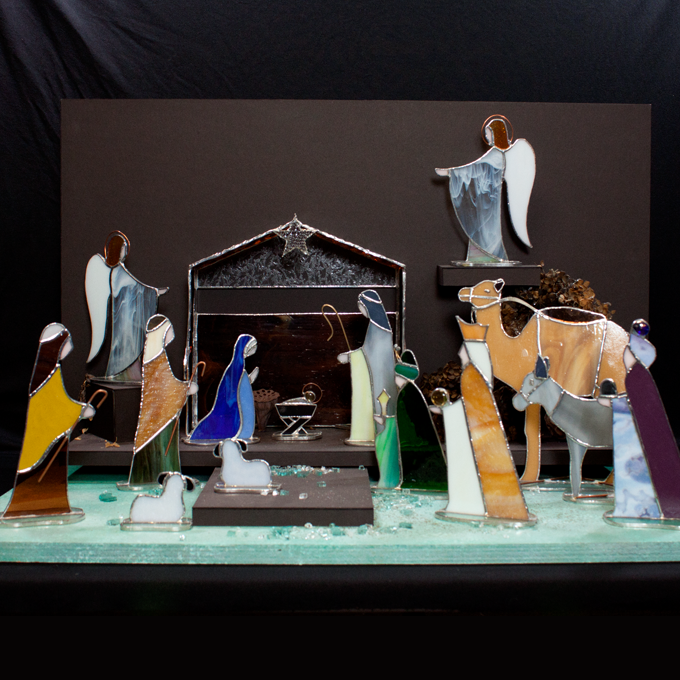
The Breaking and Sharing of Light
Jo Leach
Dayton, OH
For centuries the beauty of stained-glass windows has lent intimacy and transparency to our churches. Intimacy brings us together, transparency makes us ready for God's message. There is something of this message in the nativity set crafted by Jo Leach. Her figures of simple lines and colored glass converge in one time and two movements toward the center marked by the star. They convey an impression of sliding, cutting the air and burning holes of light in the darkness as they move. Two dimensional, they take up little space and offer their generous surface to the whole impact of Christ's revelation, sharing some of his light, colorfully broken, with each one of us.
– ML.2614
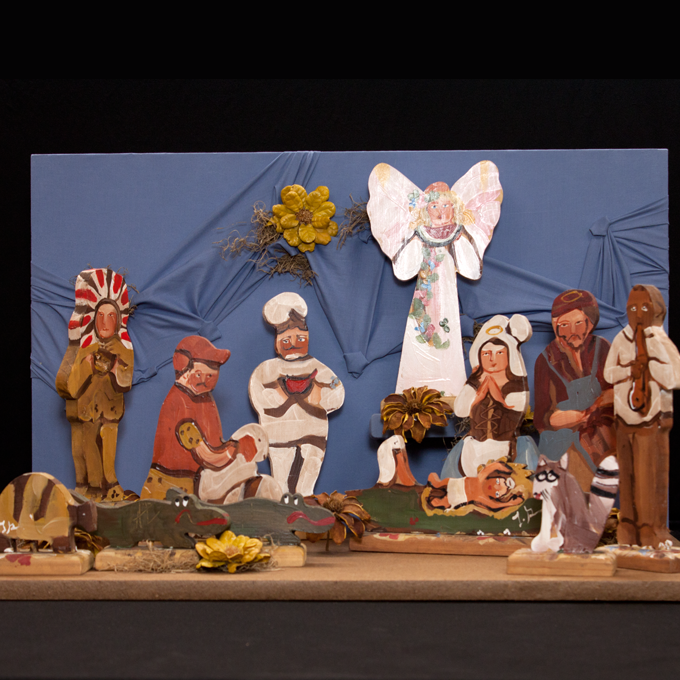
A Cajun Nativity
Lorraine Gendron
From the Acadian Evangeline reenacting Mary, to the Watermelon Angel and the Jazzman playing Wiseman, this nativity is a touching blend of Nova Scotia and Louisiana, a cultural mix of North and South.
– ML.1122.01
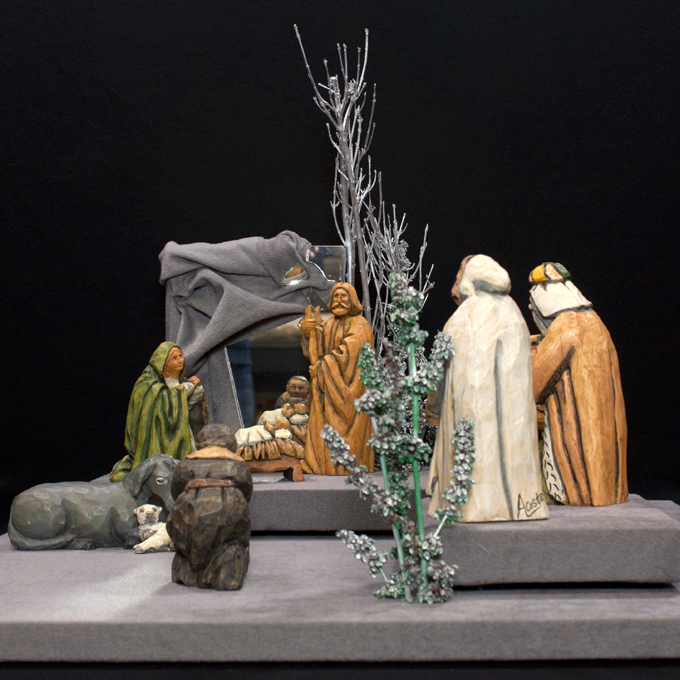
Out of Tolkien
Silvestri Collectable
The sturdy-burly figures of this set elicit associations with the rings and roots of Tolkien's world. Are they escapees of Middle-Earth or distant relatives of the Hobbits? The Hobbits gave old gifts to old friends. The older the friendship, the more ancient the gift. A well-worn gift was a sign of deep love. Let us not forget that the Christ child is our oldest and most precious gift.
– ML.2138
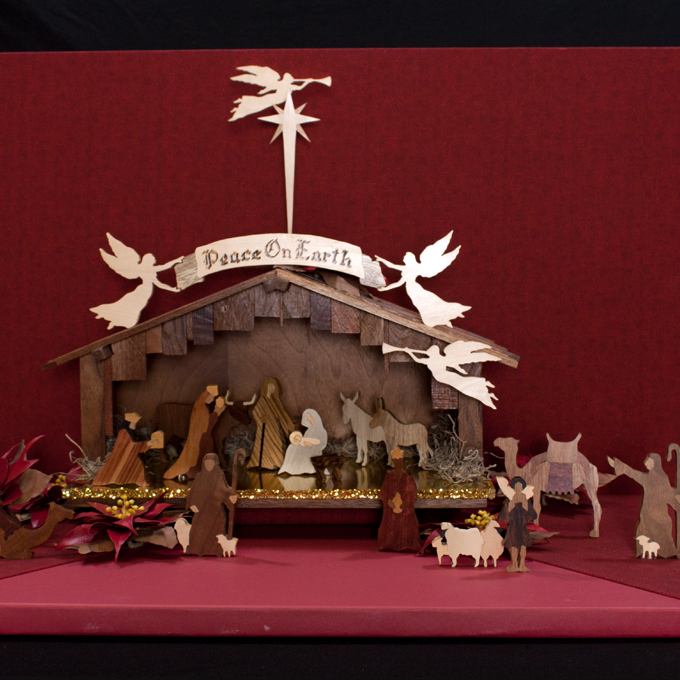
Wonders of Wood
John F. Weber
The barn is of Walnut, the manger of Rosewood (India), but guess what woods were used to make Jesus, Mary and Joseph? The Holy Family was crafted with a symphony of woods: Robe-Buckeye, Halo-Satinwood (Sri Lanka), Blanket-Maple, Flesh-Luan (Philippines), Robe-Zebrawood (Africa) and Hood-Poplar. From Africa to Brazil and the Philippines, these wonders of wood are extolling the wonders of creation and its recreation in Christ.
– ML.0132.12
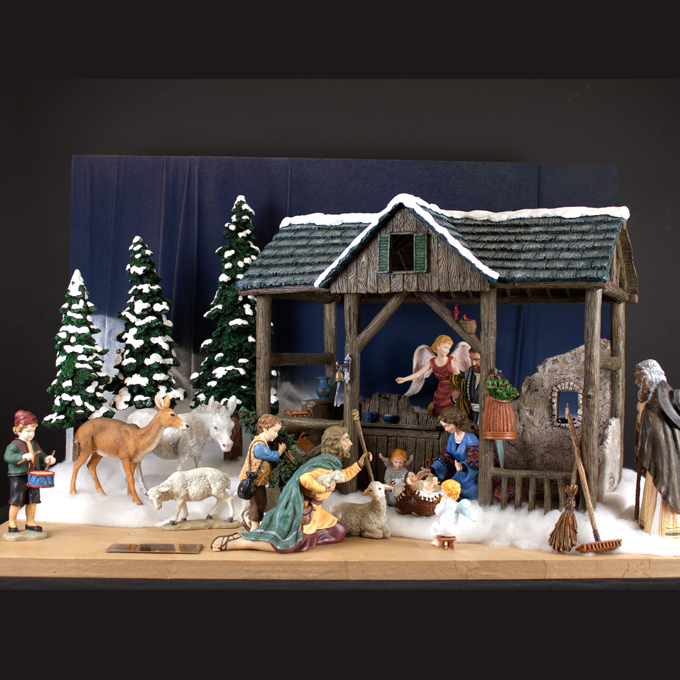
First Experiences
Pipka Ulvilden
Pipka has created a Nativity set which has all the ingredients of sentimental appeal and sweet memories. It suggests a white Christmas. There is the little drummer, the tender fawn and meek donkey, the boy with the lamb, and angels of all ages. The stable is sturdy and drafty, but it presents the essential comforts of home: pots and pans, candle, and house bell, even a wicker basket filled with flowers. Saint Joseph holds the customary lamp, and the mother reflects the fresh beauty of a Madonnina by Raphael. Not to forget the elegant flourish of the adult shepherd's sincere tribute to the baby. It all seems to be right; right as it should be, right as it was when we first experienced the Christmas event. First experiences have a lasting effect as they shape our expectations and mark our imagination. Retrieving and purifying them would seem like a salutary challenge, provided our first experience is also the beginning of a new experience for the present.
– ML.2650
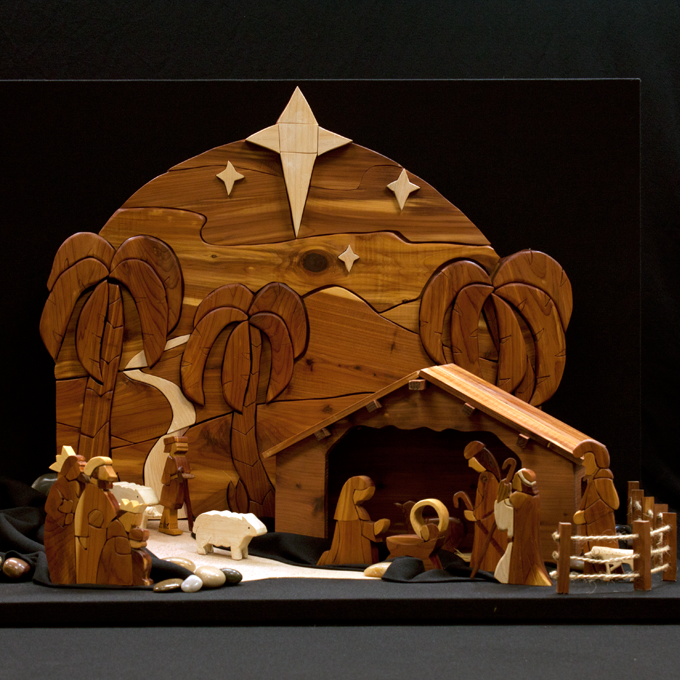
Mosaic of Wood
Evelyn Martin
This nativity set is a mosaic of wood consisting of more than two hundred pieces. Termed Intarsia, the many elements of the crèche are fitted into a support, and suggest the long road to Bethlehem, meandering through a Mid-eastern landscape. Made mainly of cedar wood, the silhouettes of the nativity figures are like escapees from a world of too much wooden harmony. Together they form the beginning of a new world at the end of a long road.
– ML.1118.01
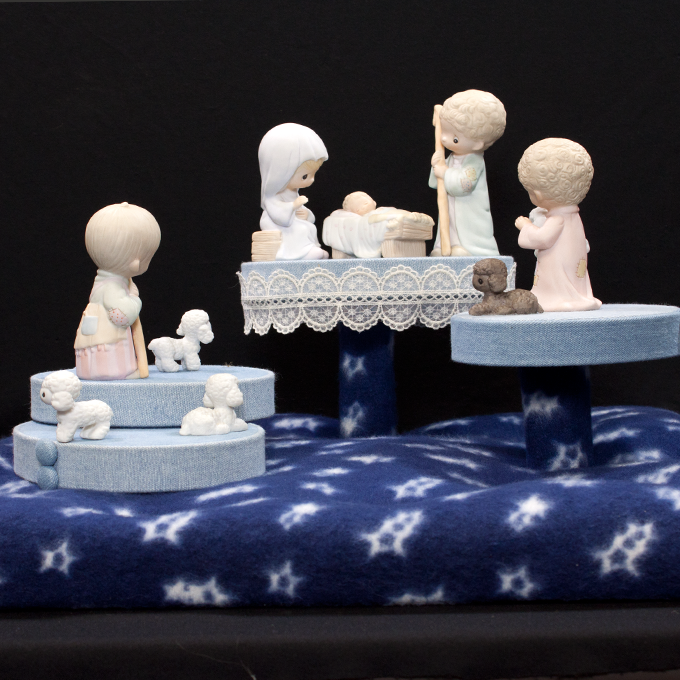
A Precious Moment
William Biel and Sam Butcher of Jonathan & David
There exists a certain tendency in contemporary Nativity sets of this country to recreate a children's world of innocence and magic. Christmas becomes a precious moment, a tempting invitation to re-appropriate for a magic instant the land of original innocence, where dreams are true life and a silver spoon has been placed in every baby's cradle. But Christmas is more than only a precious moment. It is a full life program for the adult with a childlike heart. Jesus had a special blessing for the truly "poor in spirit": "I bless you, Father, for hiding these things from the learned and the clever and revealing them to mere children.
– ML.0070.31
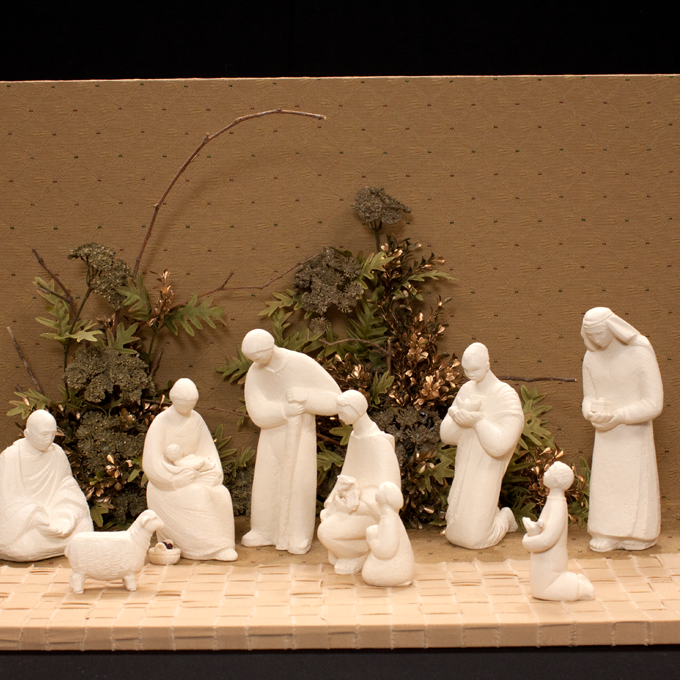
Each Bringing a Gift
Trina Paulus
The figurines are part of Trina Paulus' Grailville Nativity (Loveland, OH), the so-called ~Shepherd Set. Here is how the artist describes her artistic experience: "Out of my fingers the clay figures seemed to flow, and the idea of each figure having a gift to bring, which has meant so much to children for generations, emerged naturally. Mary with her empty lap (the baby can be removed) to wait through Advent in expectation until a child puts the little baby into her arms on Christmas Eve, the girl with her basket which can be filled with seeds or berries, the boy bringing his dove, the shepherd comes with a lamb, and Joseph, the watcher and guardian -- all these were there." This set strikes an artful balance between the intense sobriety of the 1960's and the perennial dignity and beauty of the human form.
– ML.0083.33
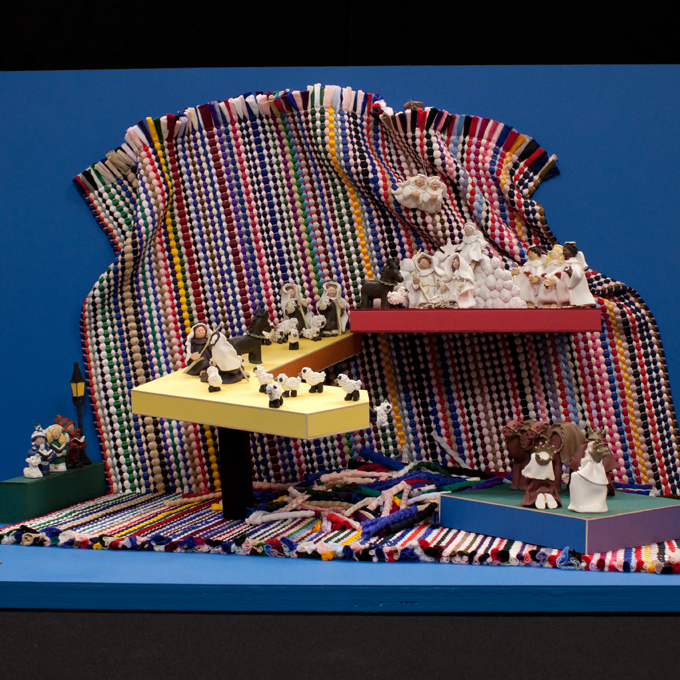
Magic Carpet
Jeanette and Penfield Richards
Casual, colorful and coquet: the cotton backdrop has all the ingredients of the magic carpet it would like to be. One that sweeps you off your feet and takes you to the wonderland of Christmas magic, which is located, as this set suggest, on the ramp to heaven. It is densely populated, as suits the region, with the white armies of the heavenly hosts hailing the Holy Family. Shepherds and sheep follow suit, only the Magi are still at some distance. All of these visitors are the baby's "best friends" with the Christ Child, you have to be at least a little like the baby: unafraid to ride the magic carpet, playful, and a friend of the angels. Take a look at the pieces of doubled yarn. It represents quite a colorful pile and is ready for usage. Build your own magic carpet, it says, for you need it if you want to reach the heavenly ramp.
– ML.0092.05
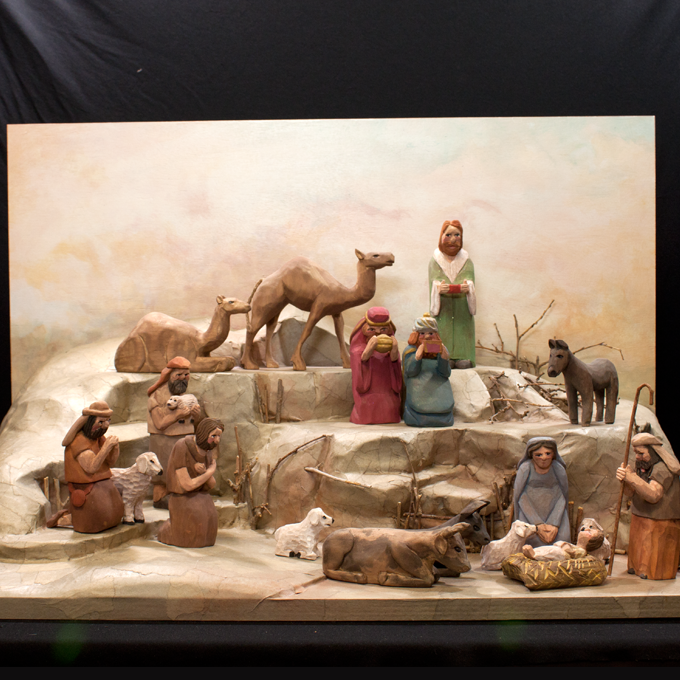
From the Earth
Eddie Walker
The same artist has created Nativity sets with more childlike and smiling faces. This scene conveys an overall impression of earthly heaviness and of gravity turned into a still-life. It seems as if the burly and crouching figures had only recently and painfully emerged from earth and rock. They have heavy feet and heavy faces. They are creatures of the earth, but rock solid, reliable and trustworthy. They do not resent bending and bowing, for they are themselves close to the earth from which they have come. And so they are close to the baby who is himself one with the earth. so called crèche mountains place the holy family in a cave at the bottom of the mount. the incarnate God had to conquer all realms and strata of reality. The last realm he conquered was that of matter. The dirt and clay we all come from and to which we shall return. These plump and heavy figures, in color of sand and soil, interspersed with a few dots of color are a timely reminder of human condition, its predicament and hope-filled destiny.
– ML.0154.22
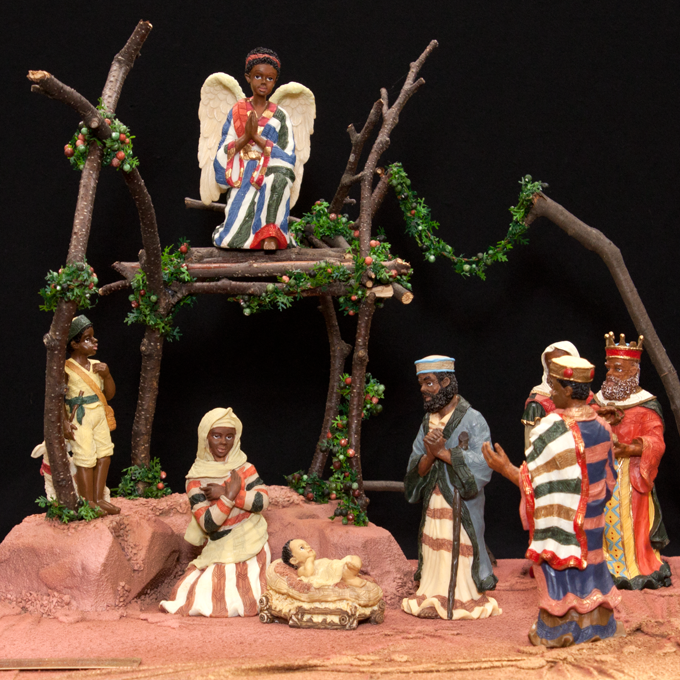
A Reminder
J. White
This Nativity has a special, almost mesmerizing beauty, not least because of the bright festiveness and rich harmony of colors and forms. It has an added feature of a more social nature.
– ML.0190.18
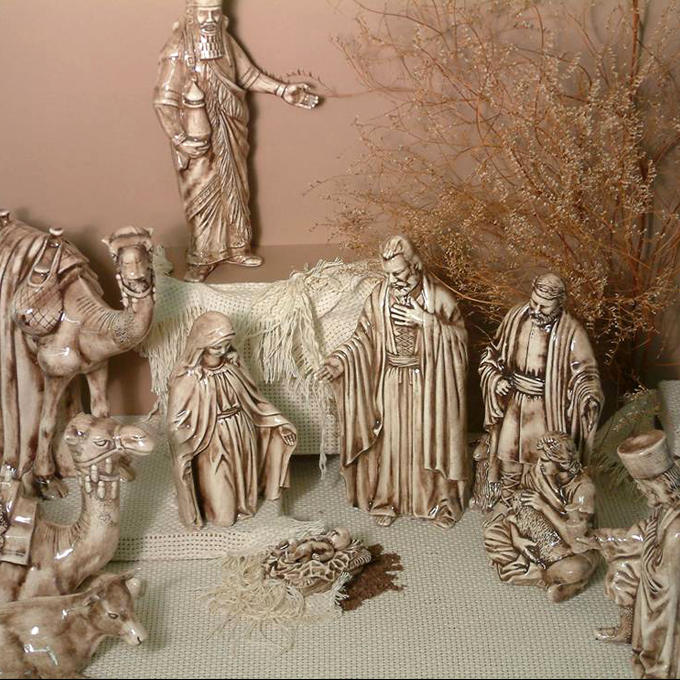
Timeless Memory
Norman Eckl
This is a classical nativity set of hard-fired bisque and vertical maroon shading. It is deemed classical because the figures reflect patterns of the so-called Orientalist style, an artistic movement prominent at the turn and well into the twentieth century. Claiming historical authenticity, the Orientalist movement attempts to retrieve the Mid-eastern culture and customs of Jesus’ times. For many people, this set deserves to be called classical because it is the nativity of their youth and their life. Noble in gesture and pose, these figures reenact the timeless memory of Jesus’ birth, then and now.
– ML.1118.02
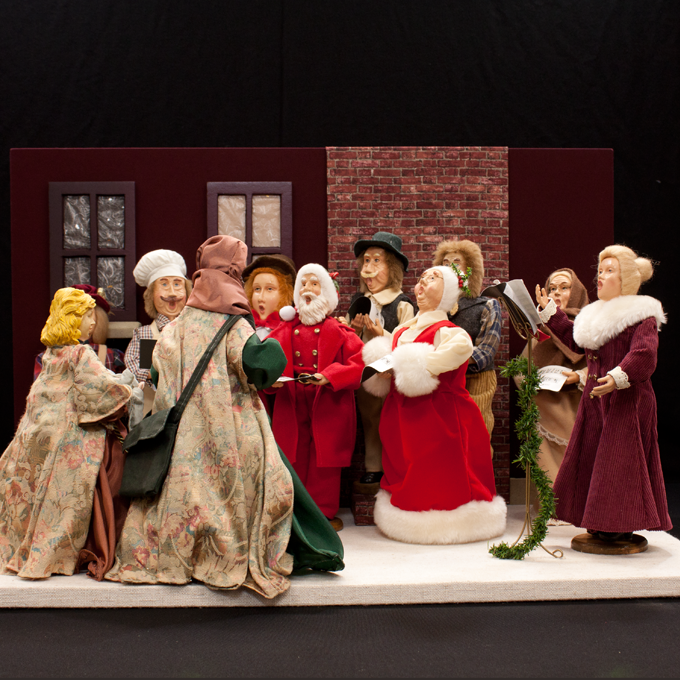
Carolers' Reward
Gerson International
Dickens’ carolers have mutated many times over. But, whether Salvation Army or seafarer, Mr. Fezziwig and Mrs. Cratchit or Primadonna and Dandy, they all have but one voice to hail the newborn king … who remains invisible. In this set, and breaking with tradition, the infatigable chanters are receiving their just reward. The carolers no longer have to search for the babe Emmanuel in their songbooks. The Holy Family stands right there in front of them: a true carolers’ reward.
– ML.1118.15
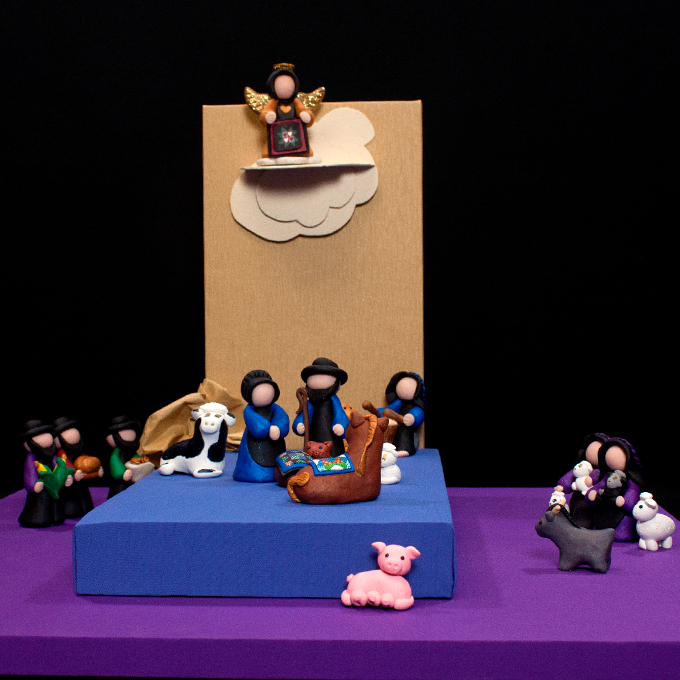
Amish Christmas
Esther O'Hara
Amish life style and clothing express separation from the world. Not the individual person, but family, community, and church are essential. The faceless people of this set point to the spiritual dimension of our lives. We need the eye of the soul to understand the grandeur of Christmas.
– ML.1118.18
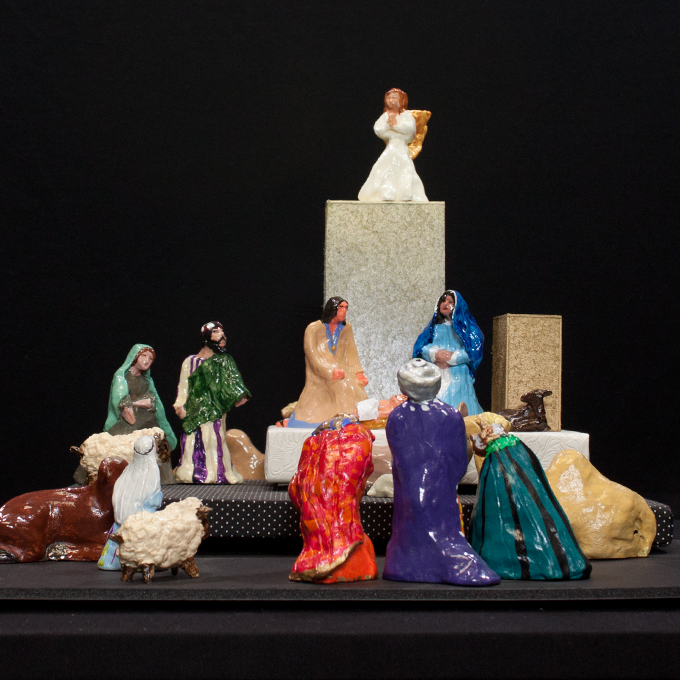
The Finishing Touch
Katherine Muench
Katherine Muench is an artist from Maine who has devoted thirty-five years of her life to the creation of her own brand of nativity figures. The overall impression suggested is one of unfinished finish. All of these figures attract the eye of the beholder, thanks to their bright colors and shining varnish. At close inspection, the smooth surfaces reveal a different reality and convey a typical message. Facial expression, the extremity of the members, even the contours of the various color fields remain distinctly unfinished. Intentional or not, the suggestion is that however smooth the surface of the persona, our inner being is begging for the finishing touch by the hand of a master artist. Christmas has been compared to the beginning of a new creation, the God-man Jesus being its master artist.
– ML.1118.21
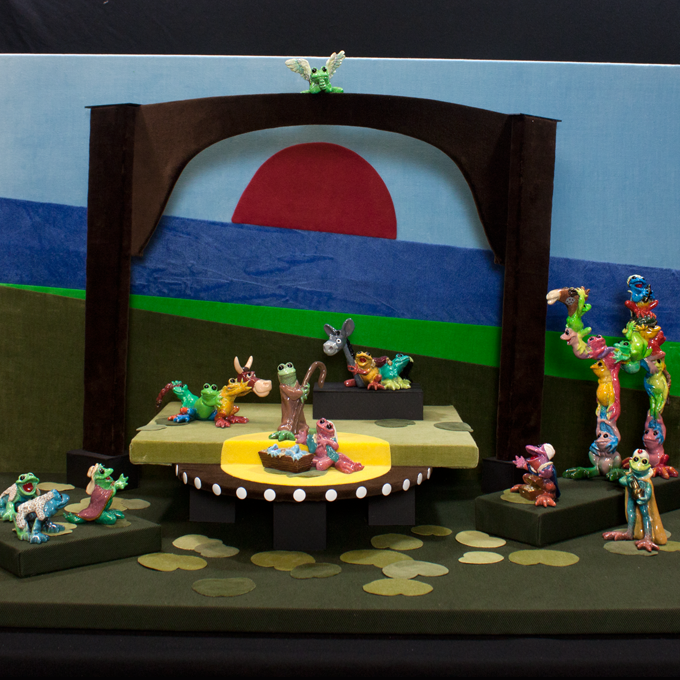
Where Logic Flounders
Kitty Cantrell
Tasteless or sacrilegious? The adult mind separates and categorizes. Not so the child. The child blends and fuses things, investing reality with meaning of his making, sometimes striking gold at a deeper level of significance. The logic of Incarnation escapes reason, but the reality of it permeates all levels of being to return original nobility to creation. Would Jesus reject any humble creature?
– ML.2162
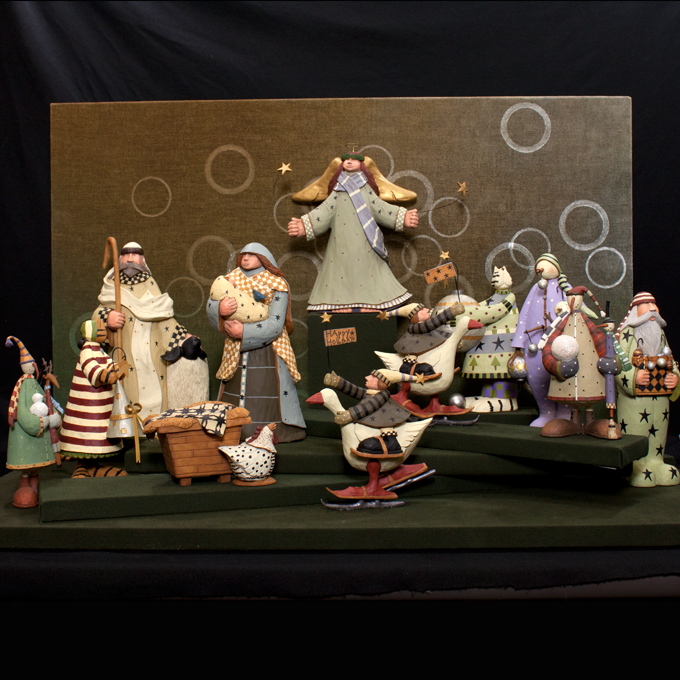
Snow Bud and Holiday Goose
Bobbe and Jeff Schuknecht
Jeff and Bobbe have a Tolkien mindset tempered and lightened by a Midwestern practical sense of humor. A “Final Touch,” “Last Minute Detail,” and “Night Before Christmas,” gathered around the Holy Family, “Flake and Friends,” and “Snow Buds” drop by together with “Christmas Slumber Party.” And here is fly-by-night “Holiday Goose” on skates. Will she stop and stay? Ask your child. Who else can understand the enchanting and bewitching world of the Schuknechts.
– ML.2506
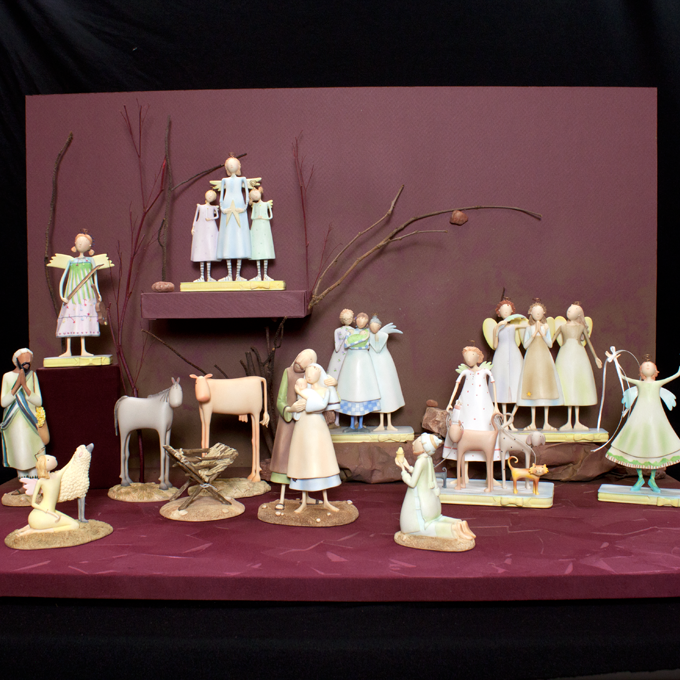
Pure of Heart
Claire Stoner
The impression of fragility and vertical imbalance, the thin and elongated arms and leg, and the subdued pastel coloring of the figures are like an anatomical reconfiguration of Gothic architecture. Claire Stoner's figures are like a sigh of nostalgia for the spiritual, the quest of those, like children, who are pure of heart—the name she gave to this collection.
– ML.2513
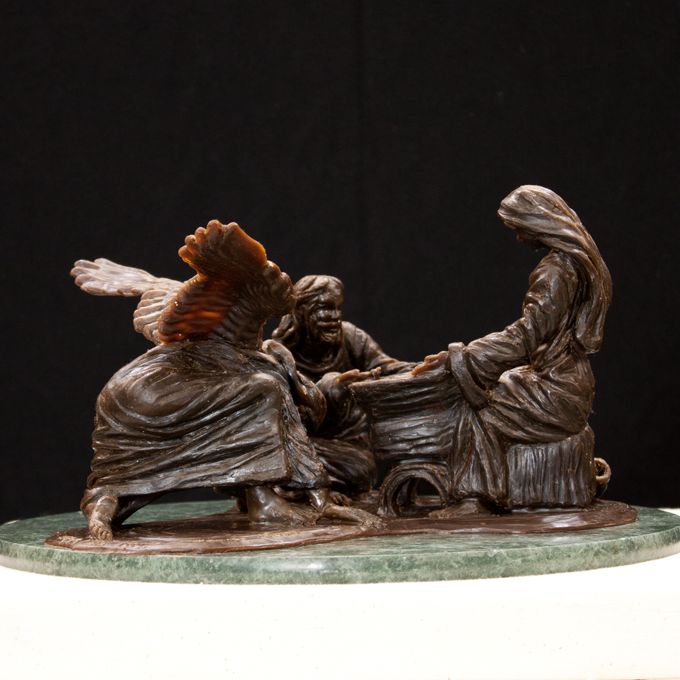
Fallen Angel
Michael Montag
Michael Montag of Elkhorn, NE, works primarily with bronze and aluminum. His passion is the casting of the human person ranging from portraiture and relief panels to full-figure works of heroic scale. Seeing value in both traditional and contemporary modes of expression, Michael's art frequently attempts to combine realism and abstraction. Here, working with black wax, the artist offers a study in movement and static. The Holy Family embodies quiet and peaceful harmony. In contrast, the magnificent angel prostrates his powerful body in awkward worship before the cradle. His posture may resemble that of a fallen angel. His superior spirit humbly praises the hidden grandeur of the Christ child.
– ML.2622
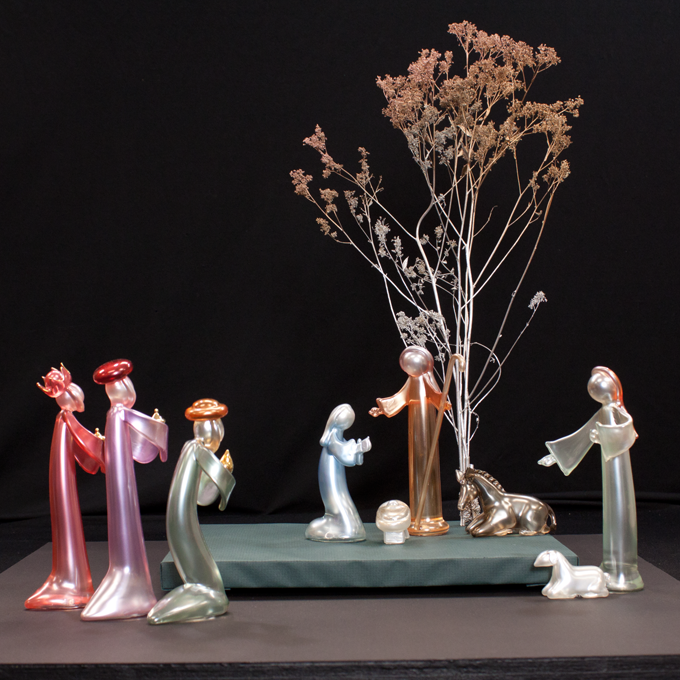
Let the Light Shine Through
M. Field
One of the highest ambitions of religious art is to make visible the invisible. Among the countless ways of attempting the impossible is the method of transparency. It works with the premise that time and space are filled with divine presence. The only challenge is to make them transparent so that the divine is able to shine through them and become visible. Icons of Eastern Christianity and stained glass windows in the West are conceived according to this principle. Thus, the saints in the colored glass windows of our churches are the ones who let the light shine through. They are transparent to divine presence. Our Nativity set, although neither by Chihule nor from Murano, reflects some of this reality. Graceful, tall and nearly transparent, these figures are messengers of divine light.
– ML.2626
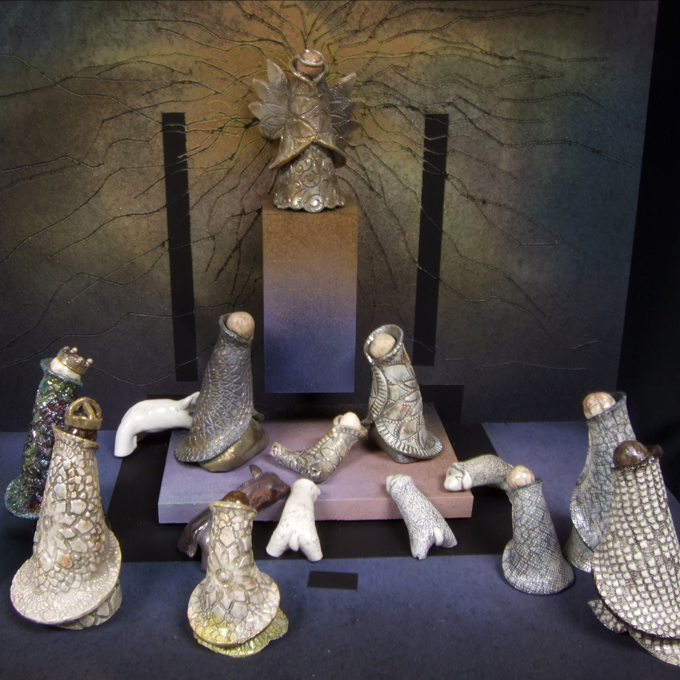
Of Single Mind
Don Smith, S.M.
Human perception moves from general to particular. General impressions come first. They are subsequently confirmed or corrected by detailed observation. Don Smith's set is all generic. There is one type of figurine, they all have the same faceless heads, they are all wrapped in the same ample cape. Most noticeable, all these personages mark the same posture of adoration. They all bend and bow and lean toward the center, where the Christ child lies. Smith aptly created a scene of silent worship, avoiding distraction and idle curiosity .With one exception. Being a master of Raku technique, he embellished the capes with decorative elements of varied and intricate design. The scene is dominated by the so called "Gloria" angel. He announces, in an atmosphere of bristling electricity , the true nature of the child.
– ML.2628
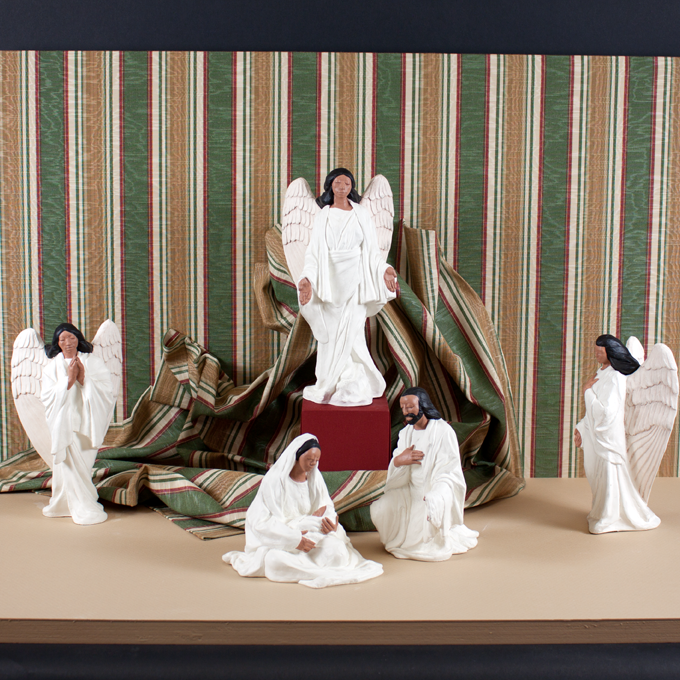
Cultural Diversity
Nova 5 Collectible
New Mexico
There are three angels in this black and white nativity set. Angels play an important role at the birth of Christ. There was a time when angels were participants in the heavenly dispute about the success of Christ’s mission. Will humans accept him? Is it acceptable for God to adopt human nature? A more classical tradition sees in the angels the witnesses of Christ’s supernatural origin. Scripture presents them as messengers of the birth of Christ to the shepherds in the field. But no limit is set to religious imagination: angels may be musicians, playful companions for the Christ Child, arranged for battle around the manger or kneeling adoringly at the foot of the future Savior. In this set, the angels play the role of announcing the coming of the Messiah and of adoring his hidden divinity. Being of black hair and faces, they highlight cultural diversity on earth as well as in heaven.
– ML.0088.34
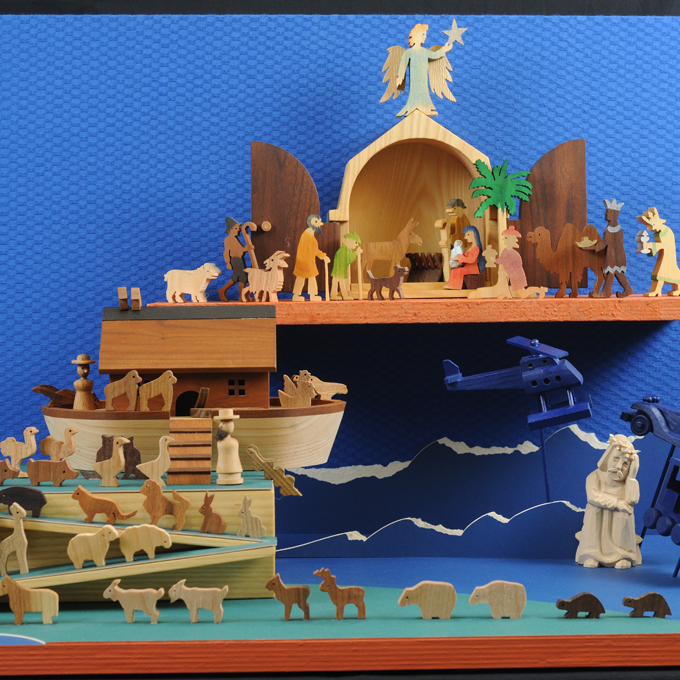
Ark and Manger
Unknown artist
Noah’s Ark leads to the manger. Both are symbols of salvation. Both serve to hold and protect. Both are eventually left behind. The big difference lies in the finality of the manger. It holds and protects the Son of God himself. No greater gift will ever be entrusted to human hands. Noah’s Ark protects human life; the manger offers God’s life. From Ark to Manger, God’s love intensifies and points out that true life is in God. We sometimes forget about the way of salvation from Ark to Manger. The Suffering Servant (Ecce Homo) is sum and substance of Truth amid distraction.
– ML.2648
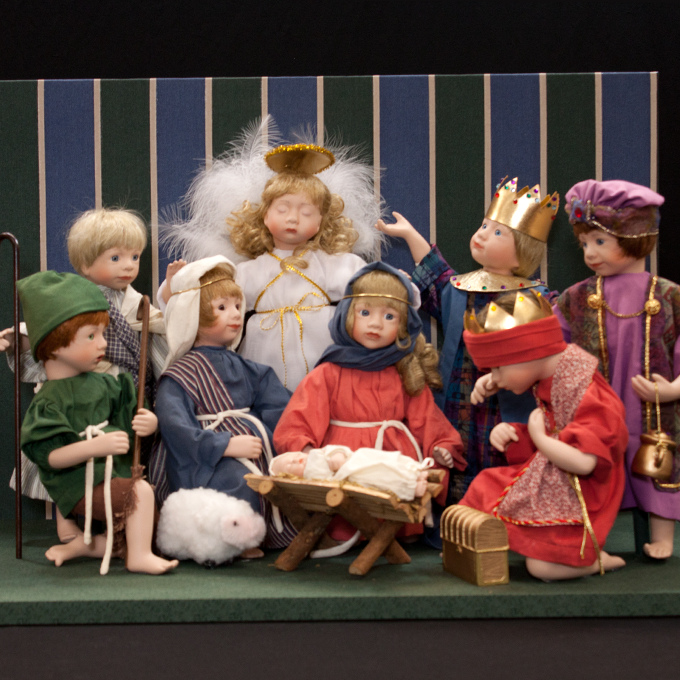
Little Prophets
Julie Good-Kruger
Dolls can be handled, dolls are look-alikes, dolls are fetishes of children and childlike souls! They represent an echo of paradise lost, and a promise of paradise retrieved. In sum, these beautiful Good-Kruger collectibles are like little prophets of the Christ Child.
– ML.0106.22
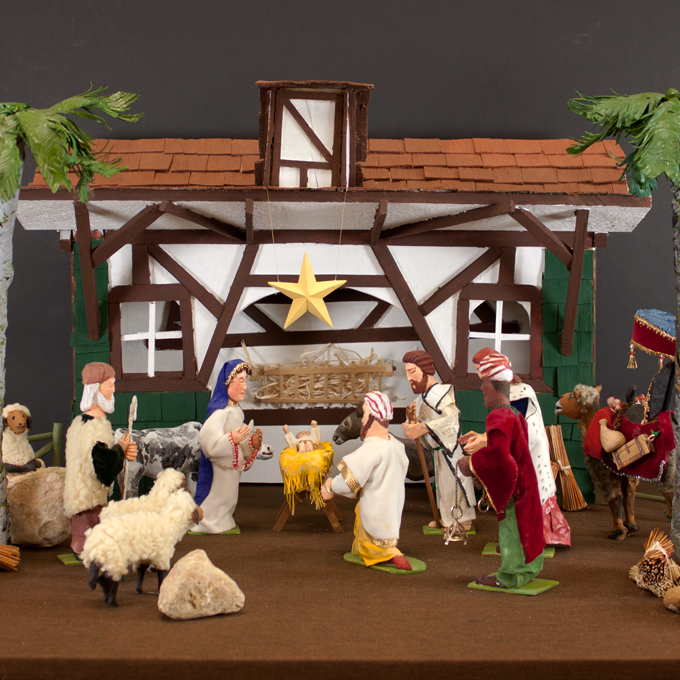
A Gift Given
Anonymous artist
C. Douglas Streiter of Indianapolis donated this nativity set to The Marian Library in 2008. In a letter her wrote: "(This nativity set) was made about 50 years ago by a resident of the St. Joseph County Home in South Bend, Indiana. It was given as a gift to my late aunt Jane who was a nurse at the facility. It is all hand carved wood and decorated with articles found in the home. It is in good condition and one of a kind. I am interested in it being on display somewhere where it can be enjoyed by the public."
In some cultures, the noblest of gifts is a gift received, treasured, and given again to be treasured and shared anew. And so this nativity set is a moving symbol of the very meaning of Christmas. It is God's gift of self in his Son ever received and ever shared.
– ML.4170
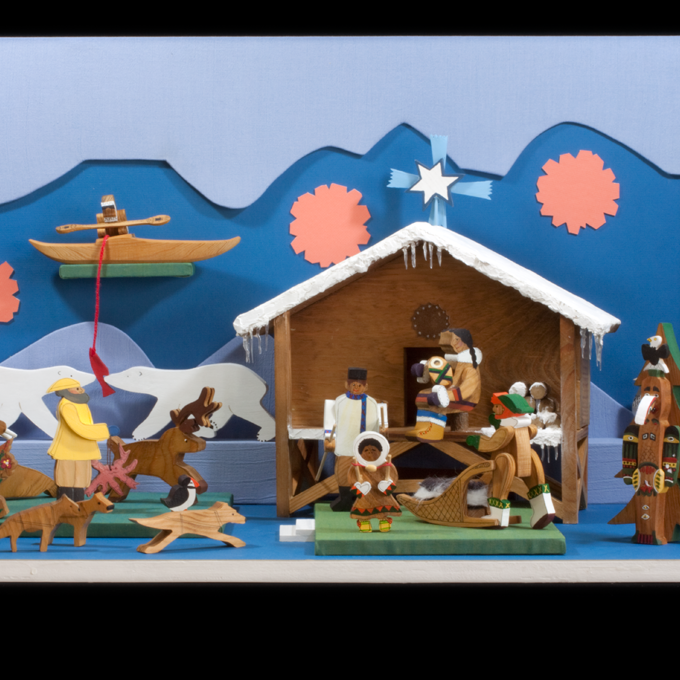
Only Icicles Are for Real
Hanneke and Les Ippisc
A kayak in the skies, three wandering sled dogs roaming free, the dog master pushing his sled, and two mighty polar bears nudging a tiny red fish: Where is Alaskan wintry realism in this nativity set? From the beginning representations and descriptions of the nativity paint a world upside down, a moment of awe and wonder, nature losing its grip. In one of the first descriptions of Jesus' birth, Joseph experiences nature, heaven and earth, animals and people, coming to complete standstill (Protogospel of James, 18). The nativity suggests a new realism, the realism of the marriage of heaven and earth. It must be… because not even the icicles in this nativity are real.
– MLA.156
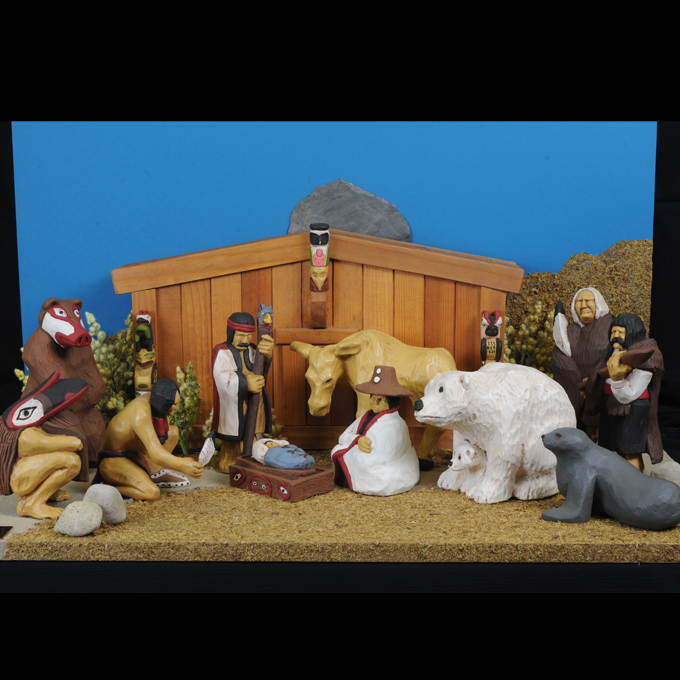
Diverse But One
Fred F. Evangel
This Nativity set locates the Christ event among the Native Americans of the Northern Pacific coast. It shows the outline of the typical Big House decorated with totem designs. The baby is surrounded by a checkered but colorful company of people, and real and mythical animals. The most prominent among the animals are moose and polar bear, pointing out that the Northwestern natives were both hunters and fishermen. Their food was deer and moose, salmon, seal, and whale. They lit their Big House with burned candlefish, and in winter wore snowshoes to hunt the moose. Their wardrobe was made up of pants, shirts, blankets, and boots. They used animal skins to protect them against the cold. The Northwestern Indians performed sacred dances donning costumes representing mythical animals such as the thunder bird, or like in this Nativity scene, disguised themselves as frog and beaver, both of them belonging -the beaver especially -to the "sacred center" of the land. Thus, this Nativity brings together in peaceful harmony many and disparate worlds: land and sea, humans and animals, hunters and hunted, myth and reality, indigenous religion and Christianity.
– ML.0088.35
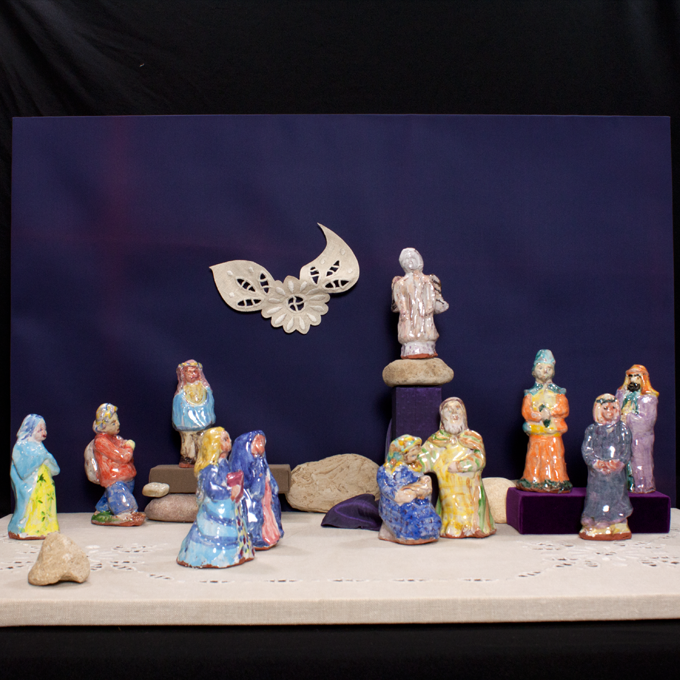
A Family Feel
Beth Watson
A "family feel" is what the artist wants to convey: Joseph attending to Mary and the baby; the shepherds bringing their wives to the manger. Balthazar does not offer a neat little box, he carries a sack full of treasures. The wisemen are humble little figures. As to the angel, there are two of them, but only one has wings, the other is an earthly angel with straw blond hair and a book clasped to her body. Since she is an earthly angel, could she also stand in for Anastasia, an early martyr, whose feast was never celebrated because it fell on the day of Christmas? In some nativity traditions, Anastasia has a place of honor and stands next to Mary. Making this nativity, Beth Watson wanted to show "that something beautiful had come and the people who came to worship come as little communities of different backgrounds."
A checkered group, from all walks of life, these figures bring with them the gentle subtle shine of majolica. These figures are made from earthenware, a type of clay fired to a lower degree than stoneware. Majolica is a glaze that is based on tin and is put over earthenware. It originally developed in imitation and as a substitute to Chinese porcelain. This is how majolica is still made today: "a tin glaze over bisque earthenware and painting with colors over the glaze, then firing."
– ML.2507
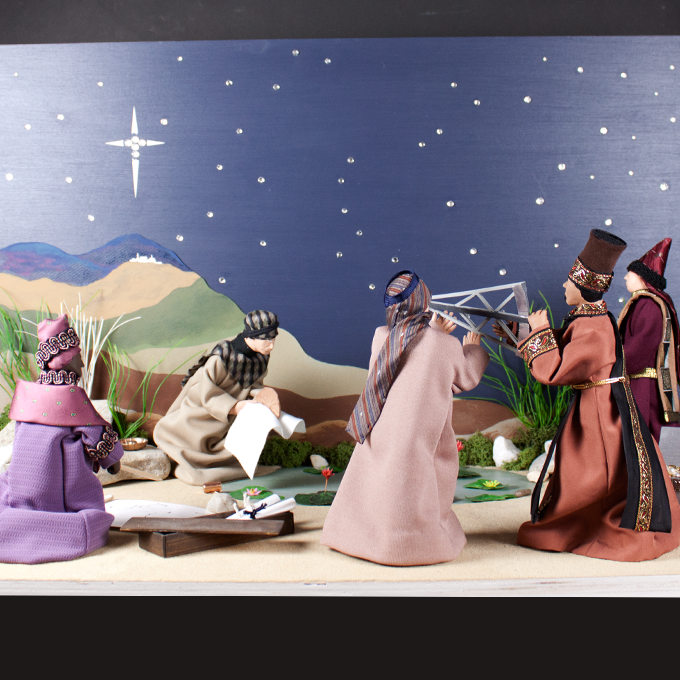
Nature Is My Home
Harry Mushenheim
There is no rest for Harry and Ceal Mushenheim’s wise men. Even on their rest the quest for the star goes on. Typical Zoroastrians, seekers of light, they are equipped with the keys of science to open the secrets of heaven. They will find the answer to their quest not in the skies but on earth, in the distant little town of Bethlehem. Not even the little paradise, looking so much like Monet’s pond with pink water lilies, will be able to tempt them . Nature is no permanent home.
– ML.4579
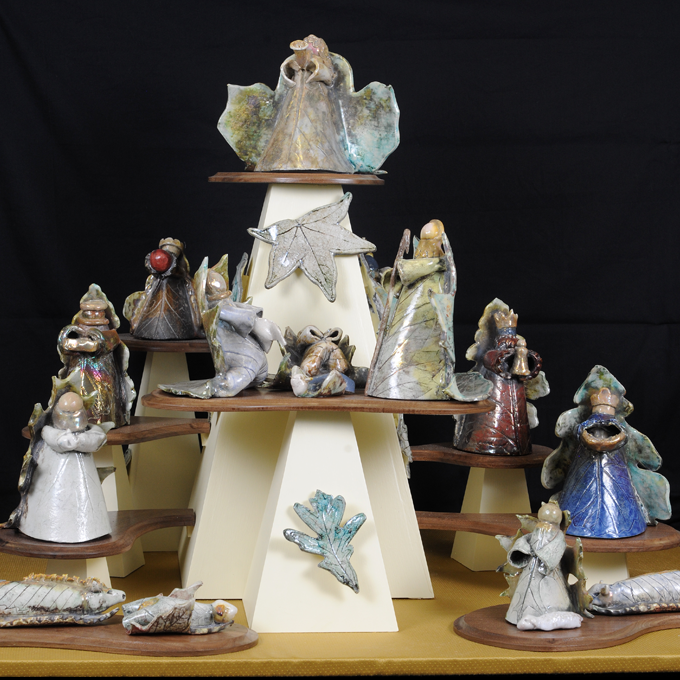
A Different Comfort Zone
Don Smith, S.M.
Raku
Being a master of the Raku technique which has its origin in the 16th century Japan, Don Smith has created a broad array of objects, some utilitarian, but most of them for the pure enjoyment of the onlooker. Enjoyment, ease, and comfort is what the word Raku means. Art is a form of evasion, the discovery of a comfort zone to ease stress and give enjoyment. Christianity is a still different comfort zone. Like the many leaves robing people and animals of this set, it wraps its promise of a new creation in Christ around our minds, souls, and hearts. Of course, leaves tend to fall but there is always a new springtime.
– ML.4506
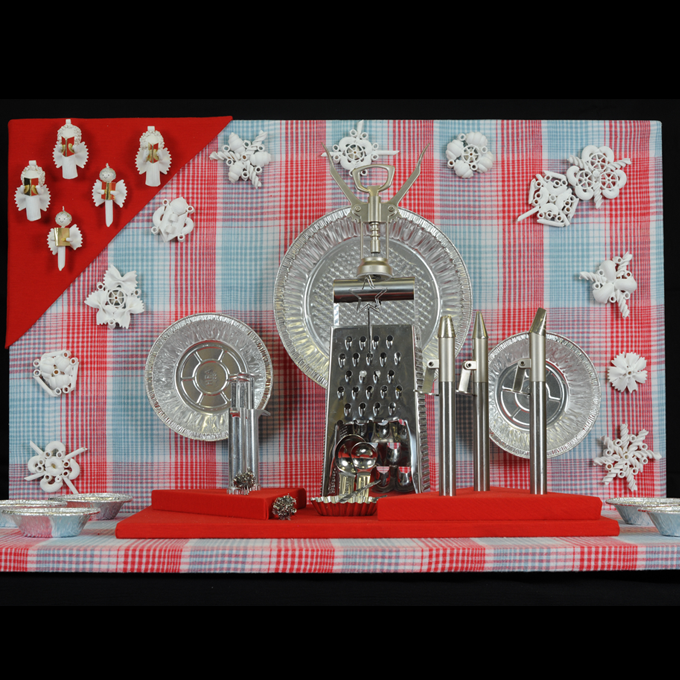
Seek and Find
Jonah Thelin Soderborg
Tin and stainless steel
You will find Jesus in the manger, Mary and Joseph, the angel, and the magi, if you seek to put yourself in the mind of the artist. This nativity set was inspired by a "corkscrew I picked up -- says the artist -- and looked like an angel with arms in celebration." The moment of discovery and wonderment let to an onslaught of creative associations: "The stable is a cheese grater, the holy parents are measuring spoons and baby Jesus is a strawberry huller nestled in a mini tart pan. The shepherds are decorating tools with the sheep made from steel wool and mini nails for the legs. The wise men are part of a kitchen tool complete with cake decorating tips used as crowns."
If you share the imagination of the artist you may find yourself sitting at the table of an Italian trattoria, in front of you a dish of pasta cooked al dente, the tablecloth a checkered red. You can almost smell the pesto!
– ML.4018
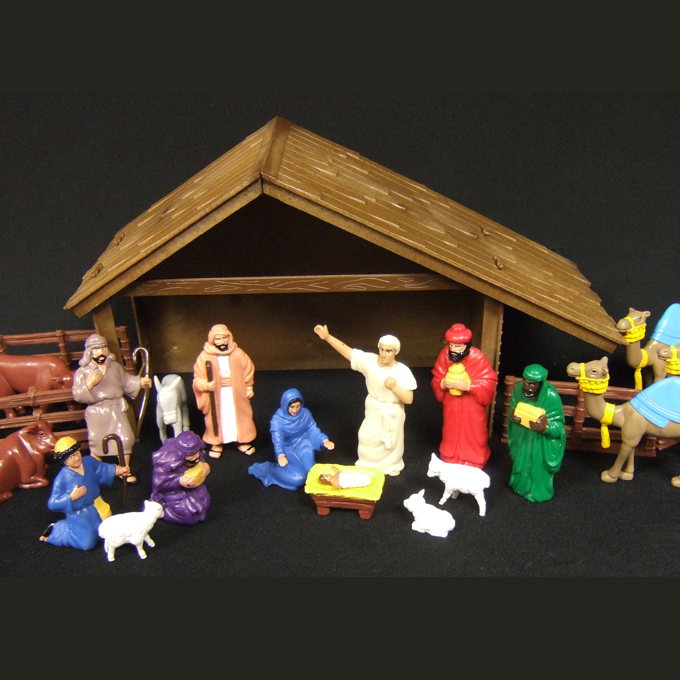
Plastic Nativity Play Set
Gift of Fr. Johann G. Roten, S.M.
– ML.0081.26
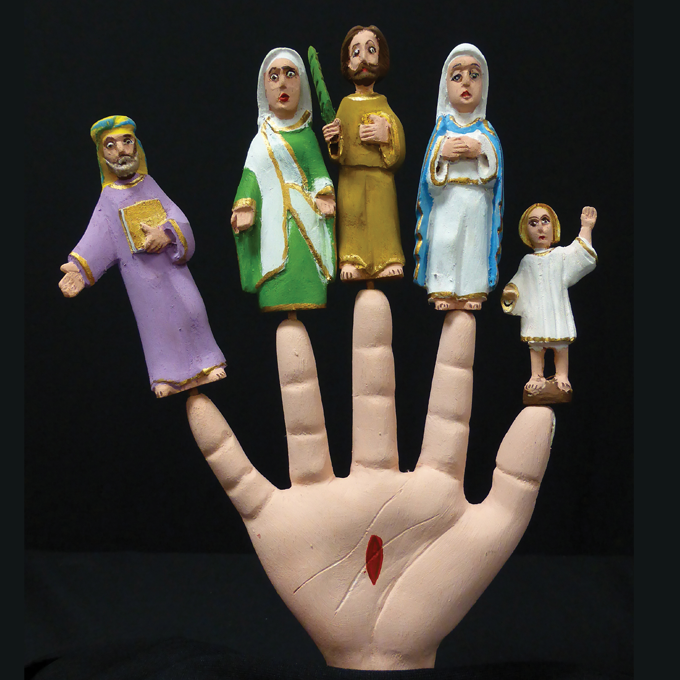
The Mighty Hand
Aurelio Lorenzo Quiñones
This unusual "nativity set" conveys a rich and poignant message. Incarnation and redemption, life and death are in the hand of God. The hand of God is a very ancient iconographical motif. The invisible God manifests his active presence in this world through his visible hand, as can be seen in many icons. In a special way, God's hand is the hand marked by the stigma of the Passion of Christ, the redeeming hand. It is also a hand that does not work in solitude. Each one of the fingers of this hand is topped and crowned by one of five saintly figures. Part of God's might is in the cooperation and help he receives from us, from human participation. The Mighty Hand, a typically Hispanic tradition, is a genealogical tree. It shows, from left to right, Joachim and Anne, Mary's parents, and Joseph and Mary with Jesus. The Mighty Hand has the meaning of an abbreviated Tree of Jesse, signaling that God is a God of history and human generation.
– ML.0122-10,11
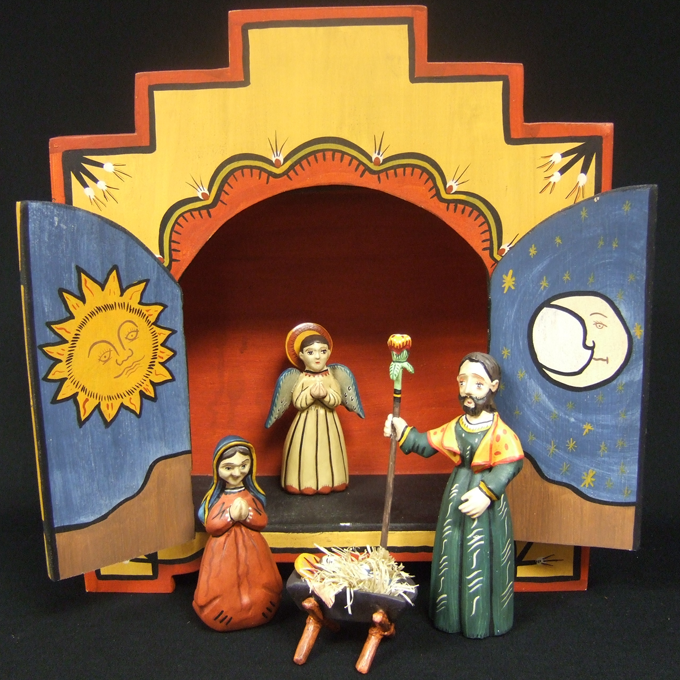
Tradition and Soul [Nativity House]
Charlie Carrillo
The “Day of the Dead” is an important day of remembrance and celebration in Peru, Mexico, and other Latin American countries. It is represented here with a somewhat gruesome Nicho (niche) from Peru. But death should not have the last word. Carrillo’s Nativity representation, in a Nicho, too, tells us that in the Christian tradition victory over death comes with the Incarnation and triumphs with Christ’s Resurrection.
– ML.0123.21
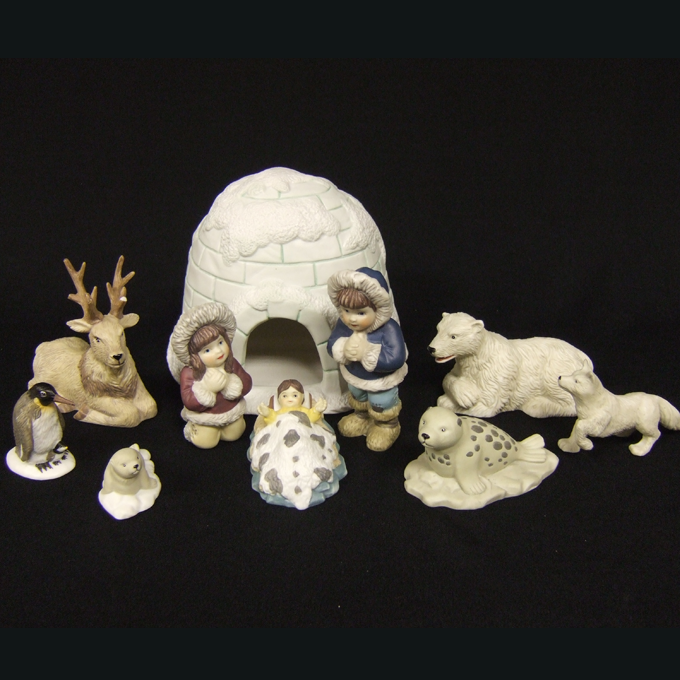
Igloo Nativity
– ML.1127.10
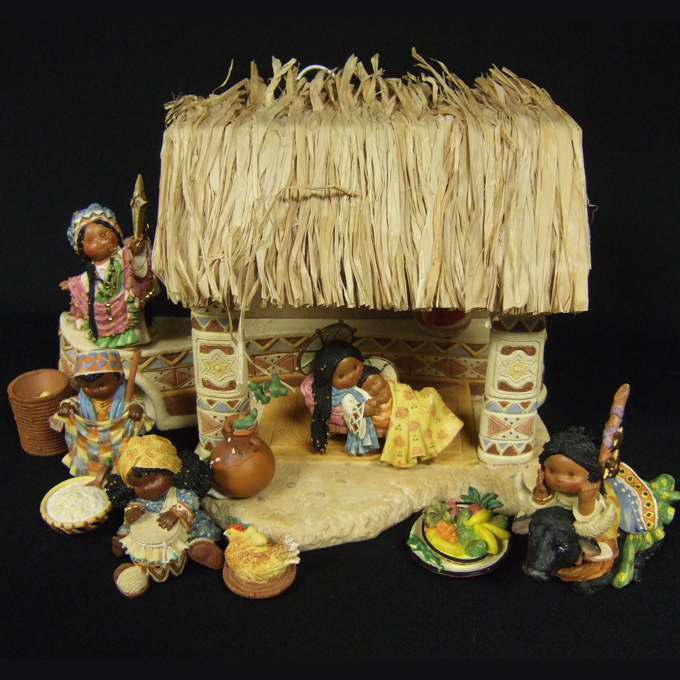
Nativity
Karen Hahn
– ML.1932
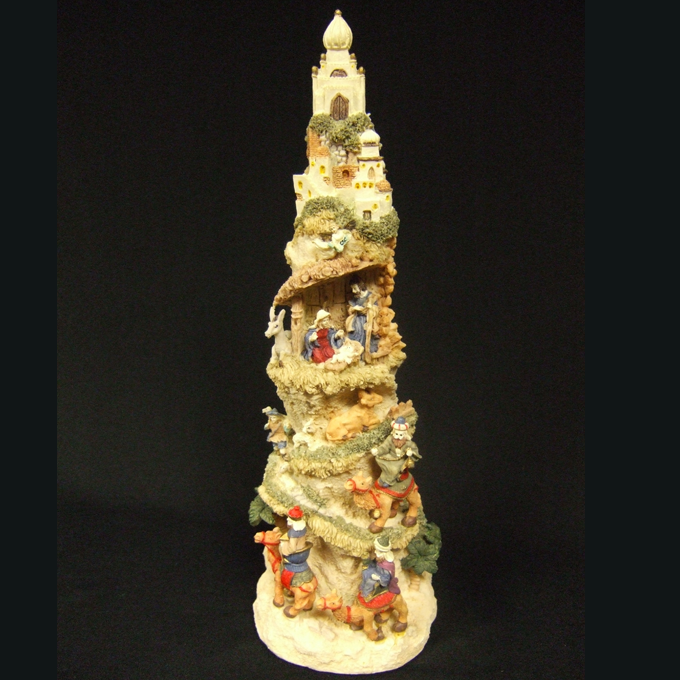
Nativity Tower
Lean and tall this Nativity Tower suggests and recreates the well known idea that the mountain is a ladder between God and the world. God descends, he comes to meet human beings on their own turf.
– ML.1788
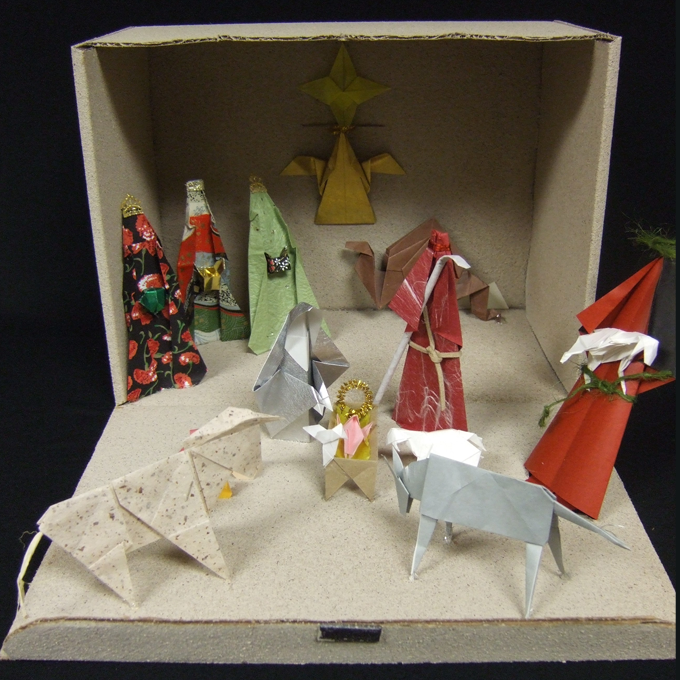
Origami Nativity
Lila and Jim Ridlen
– ML.2495
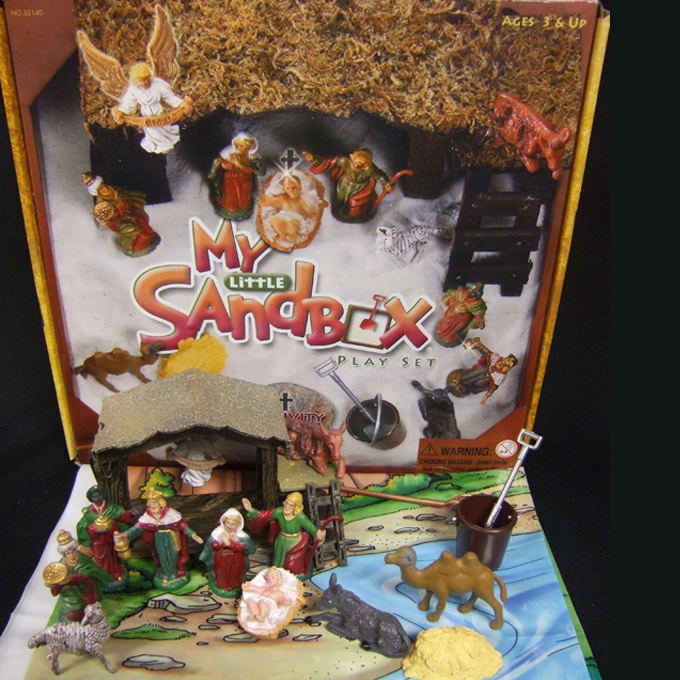
Children Nativity: My Little Sandbox Play Set
BE Good Company
– ML.2505
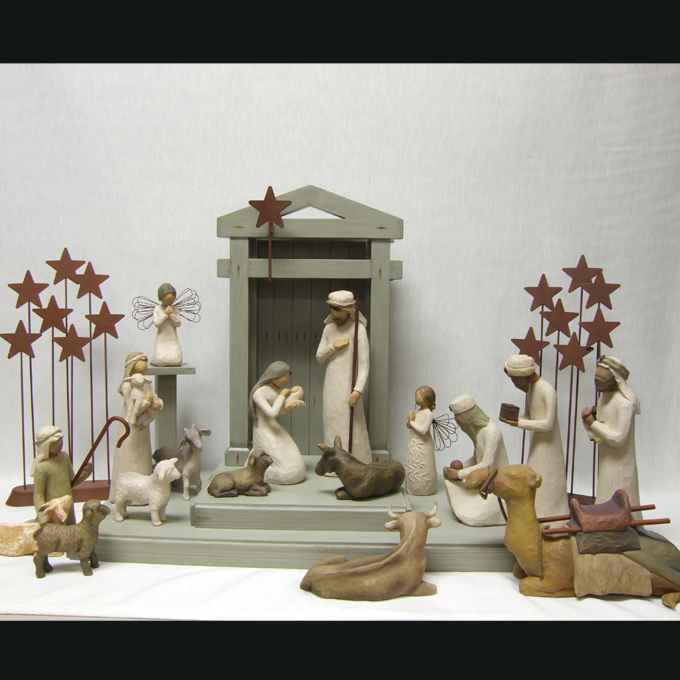
Soul and Face (for Willow Tree)
Susan Lordi
A well known collectible, Willow Tree figurines are faceless but not soulless. There is a noble simplicity in the tall and light colored personages inviting silent adoration and joyful contemplation of the Newborn.
– ML.4400
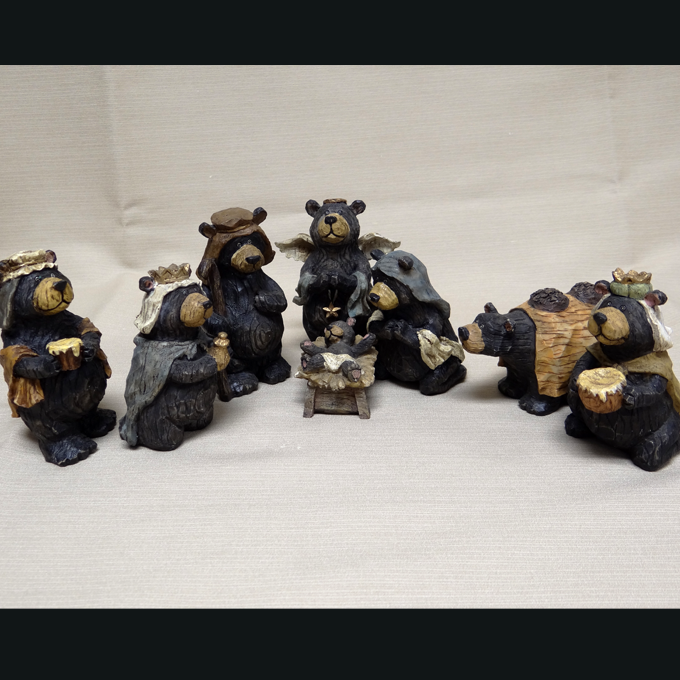
Adoration of the Magi
Kurt S. Adler
– ML.5511.62
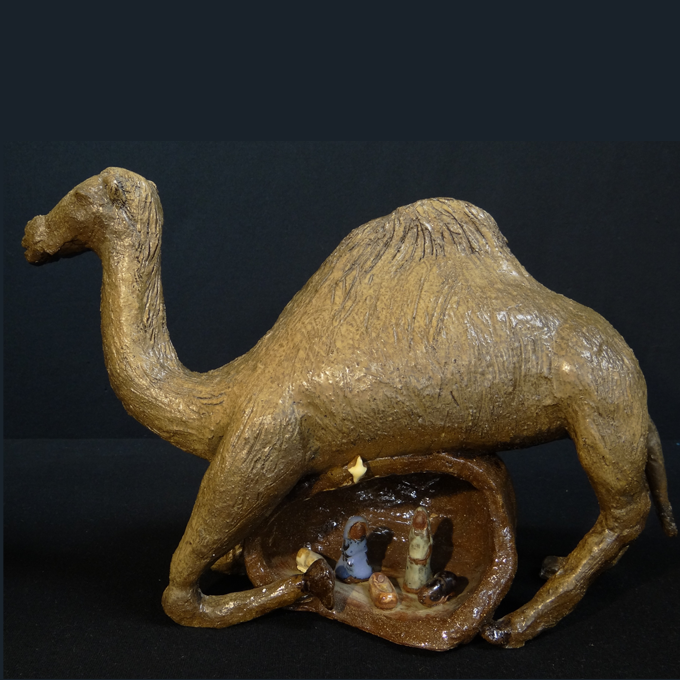
A New Sense of Creation [Camel Nativity, Horse, Elephant]
Michele Devitt
Converging toward the manger shielded by the monumental camel the mass of wild and tame animals is like a visual translation of Saint Francis' Hymn of Creation (1225). "All creatures of our God and King, lift up your voice and sing, Alleluia, alleluia!" It echoes the inspiration of a different time and a different religion: "Creative then became the glory, with self-sustaining principle below, and creative energy above (Swami Vive-Kananda, Hymn of Creation, +1902).
– Devitt.278c

